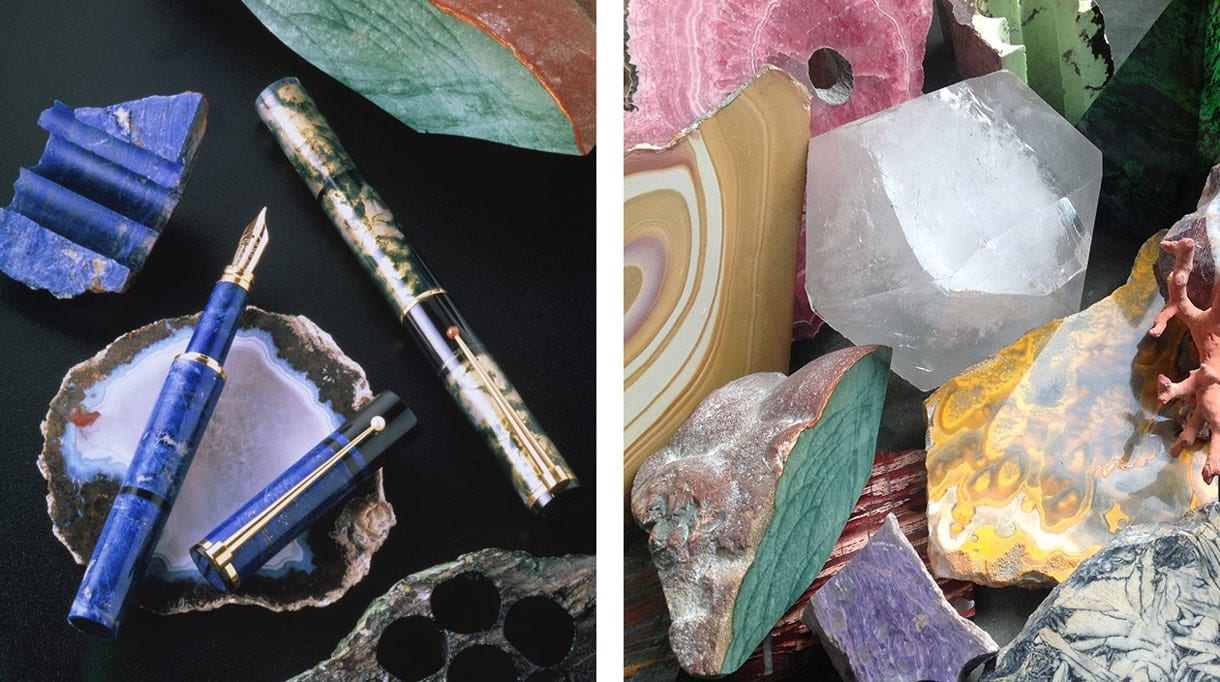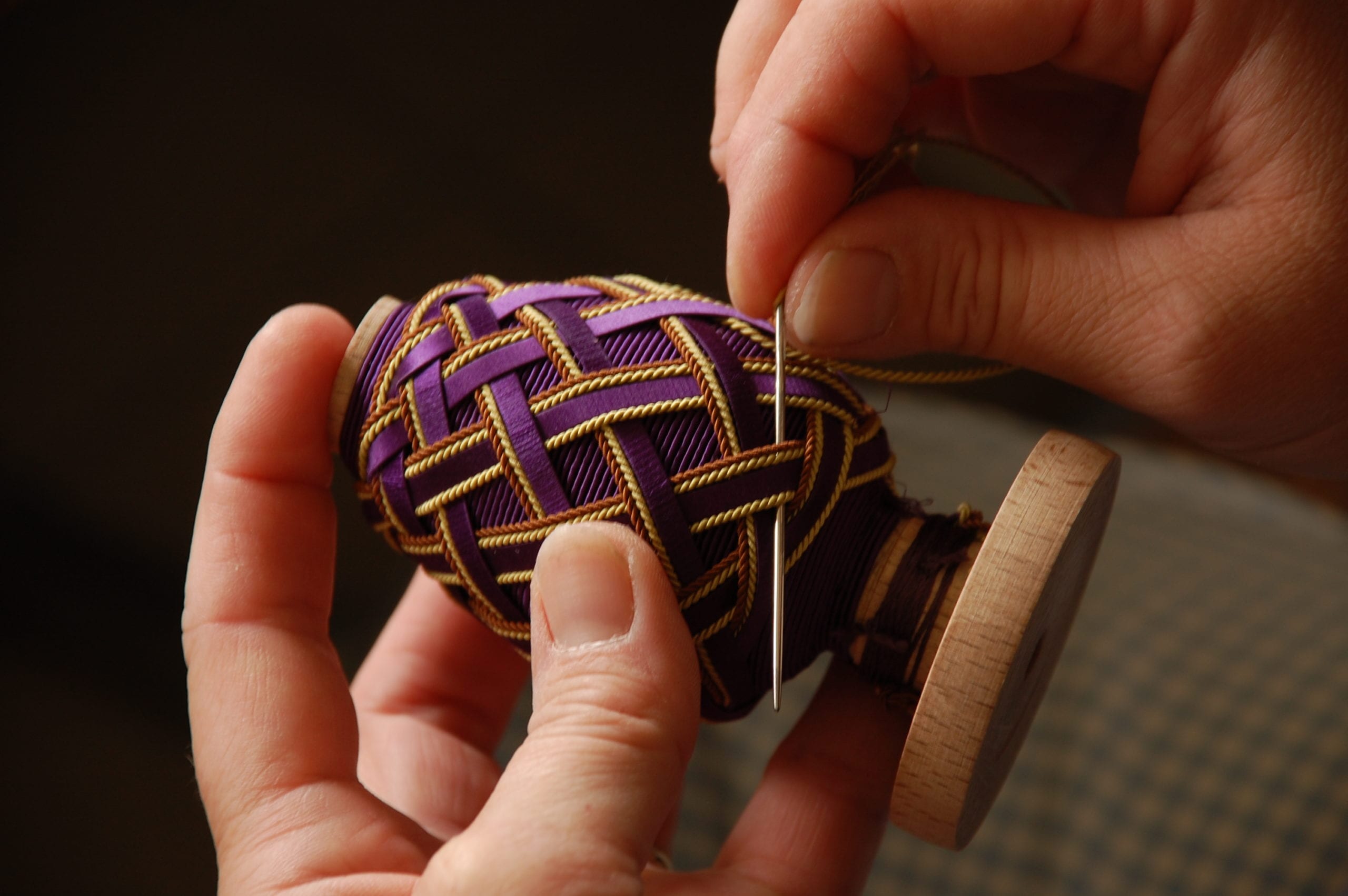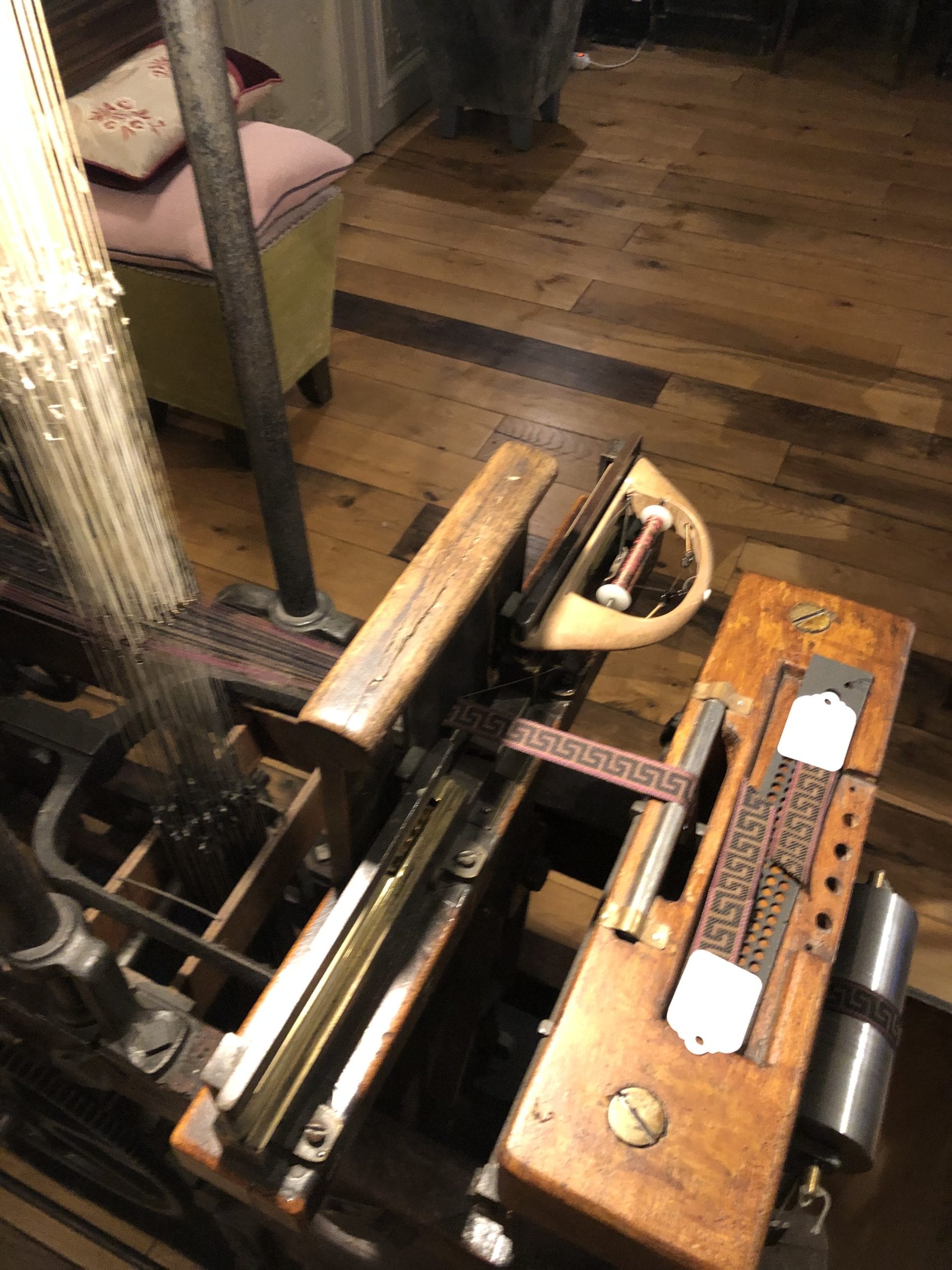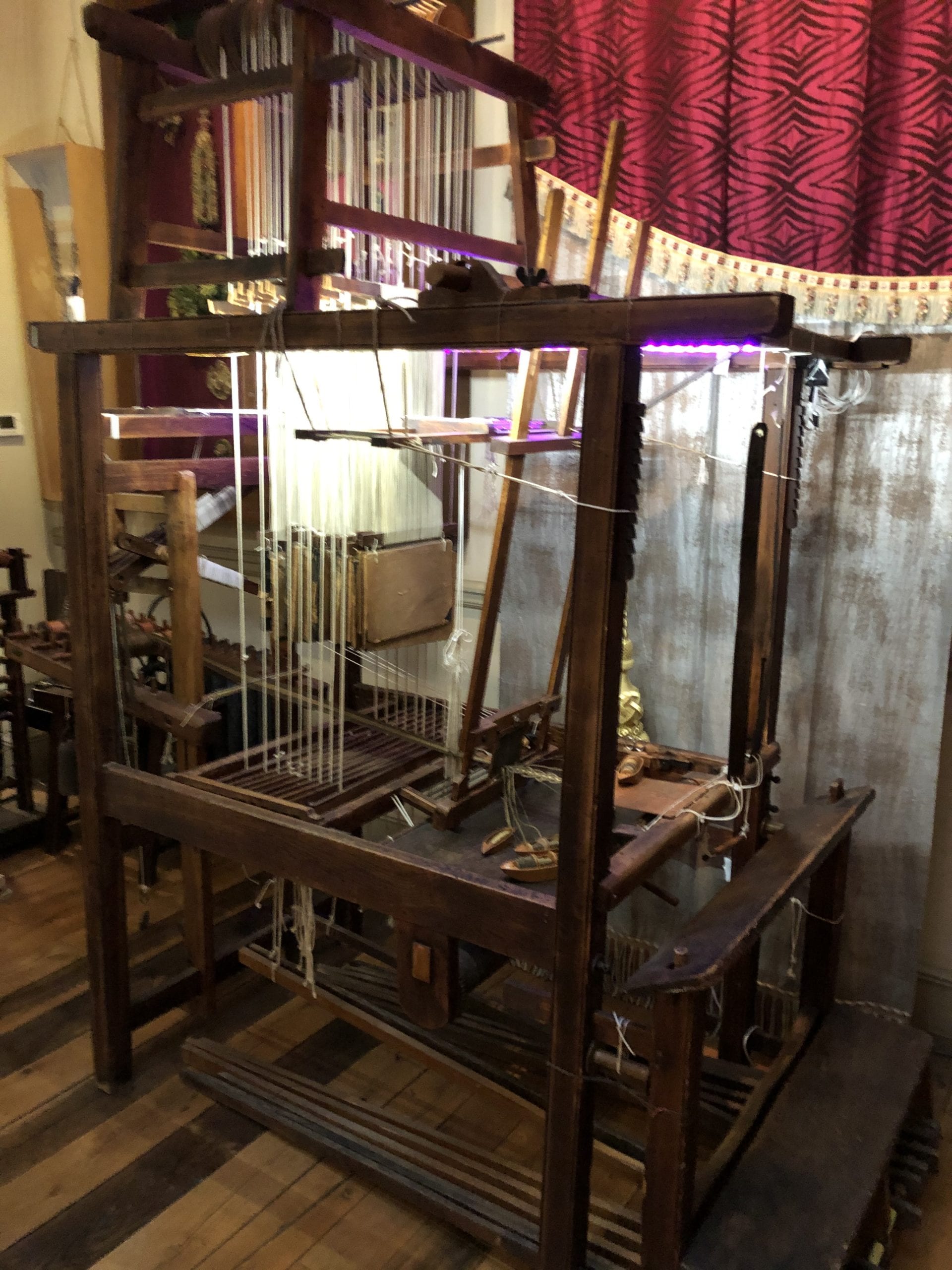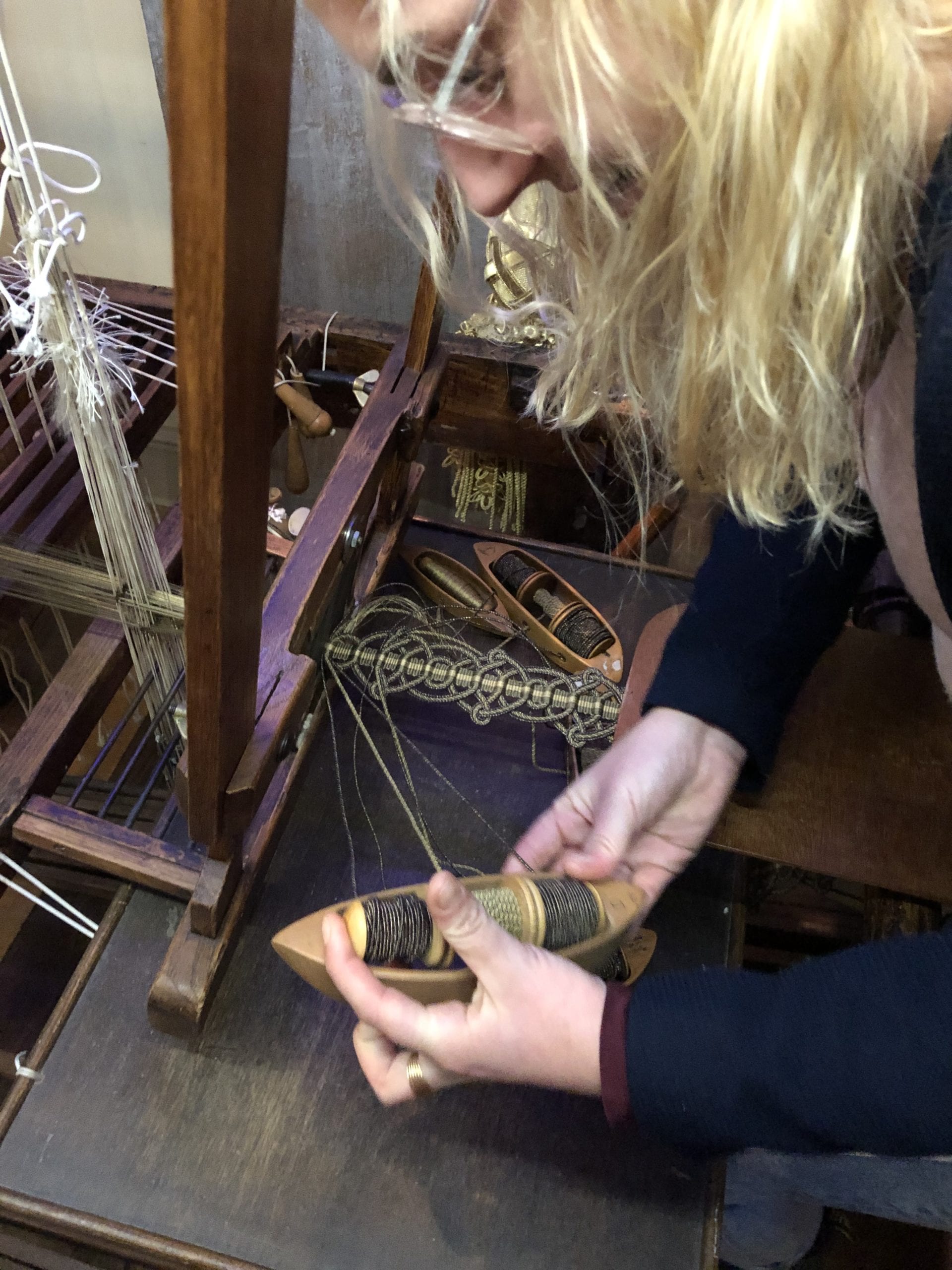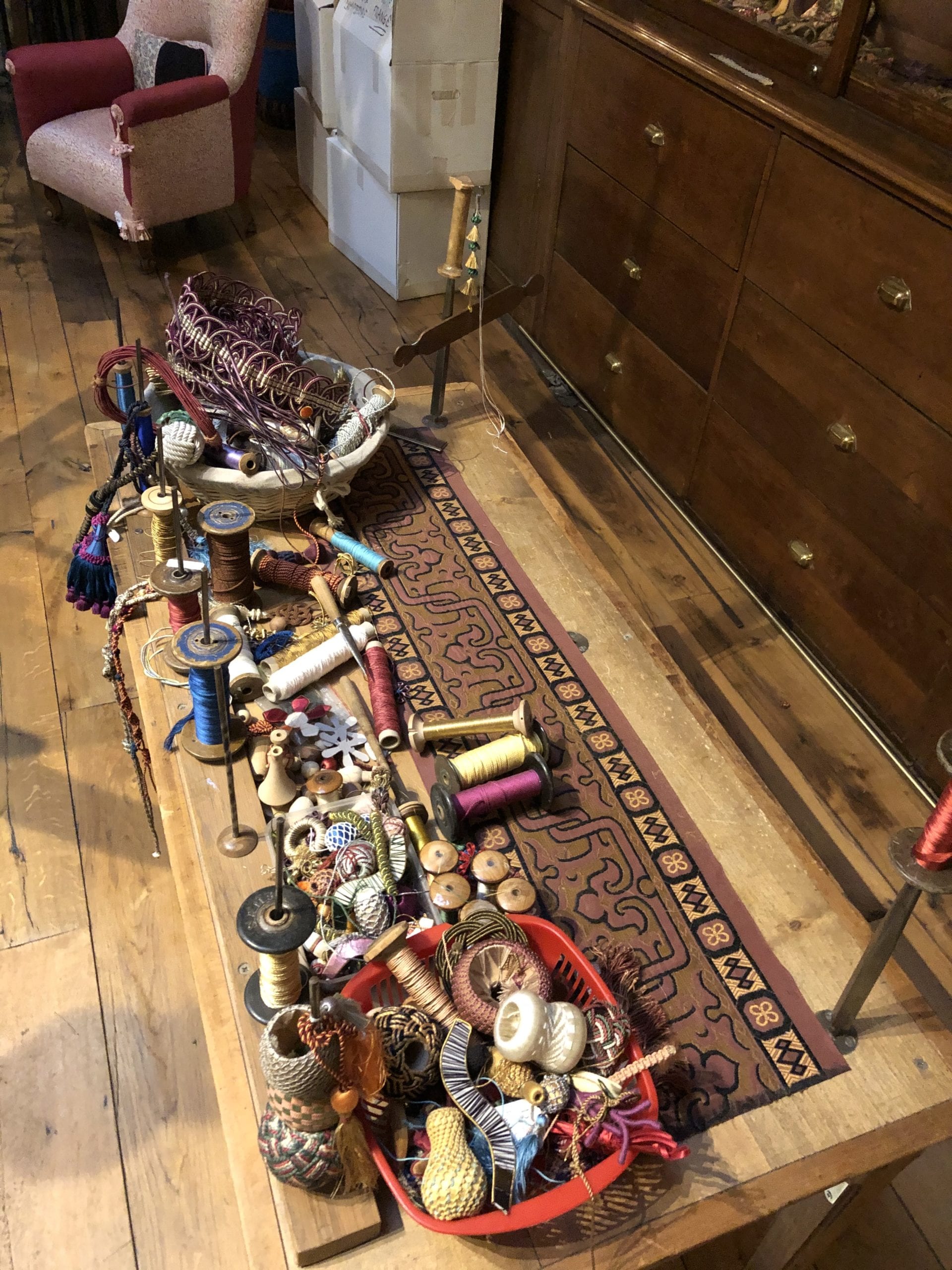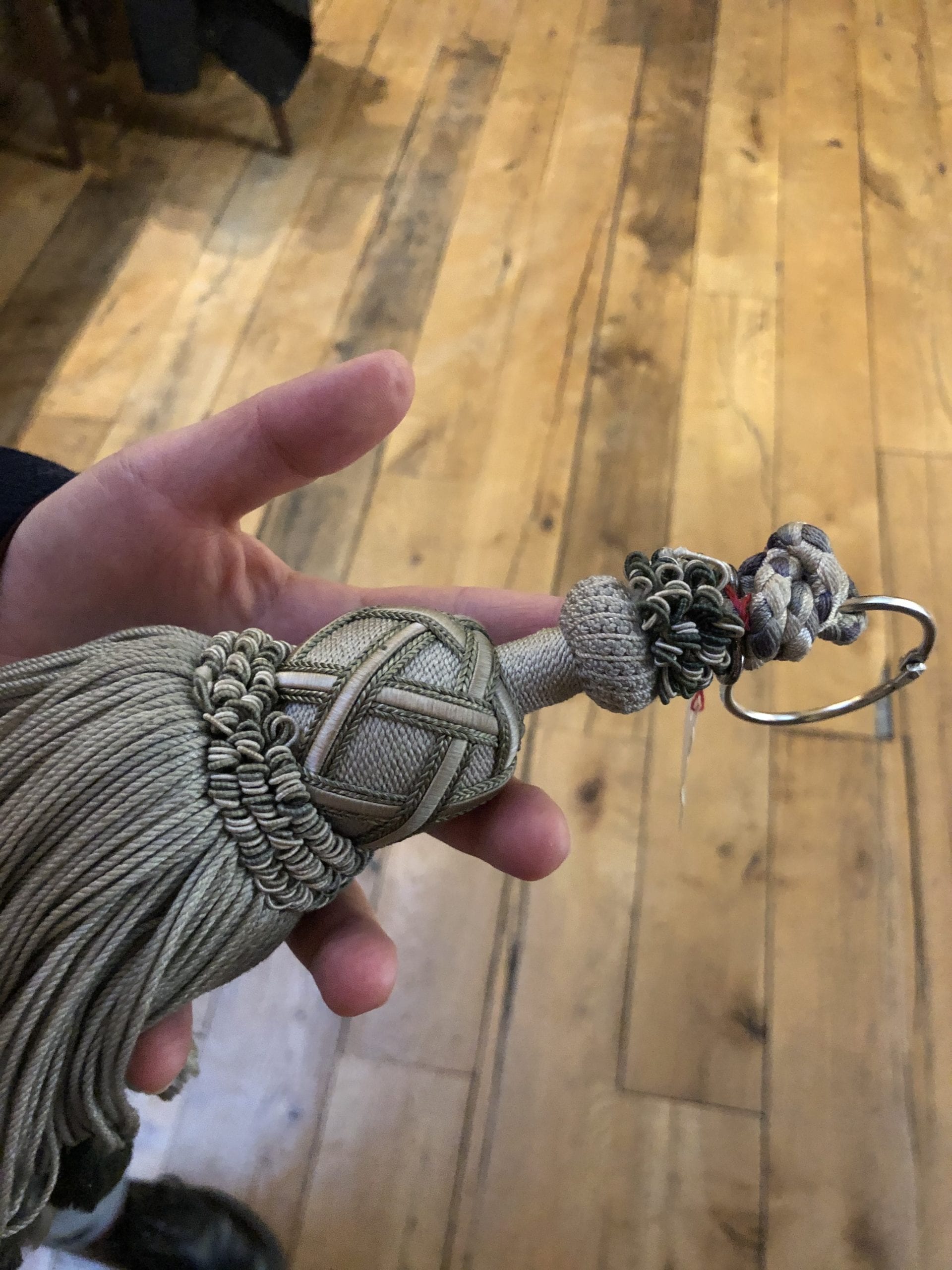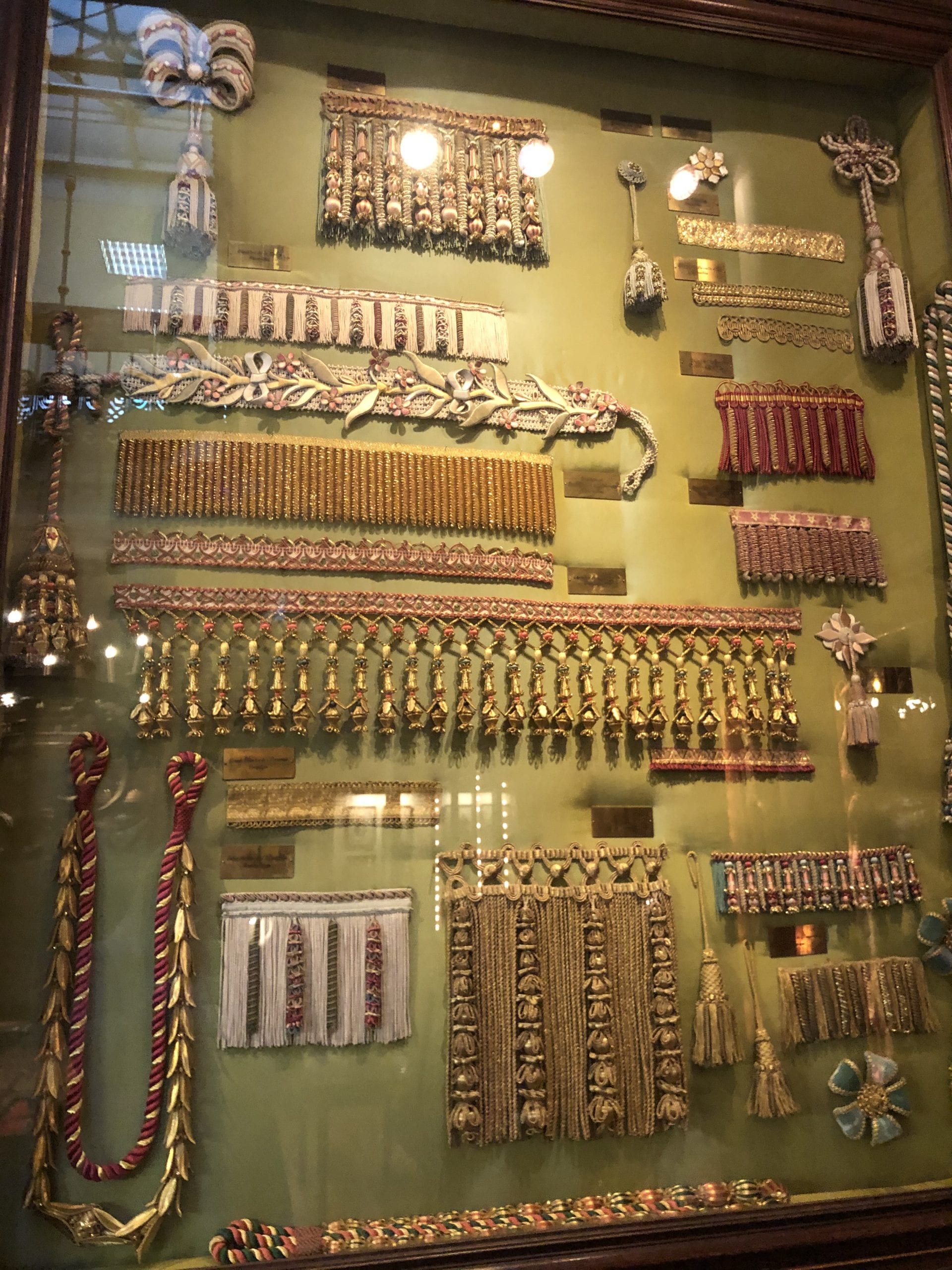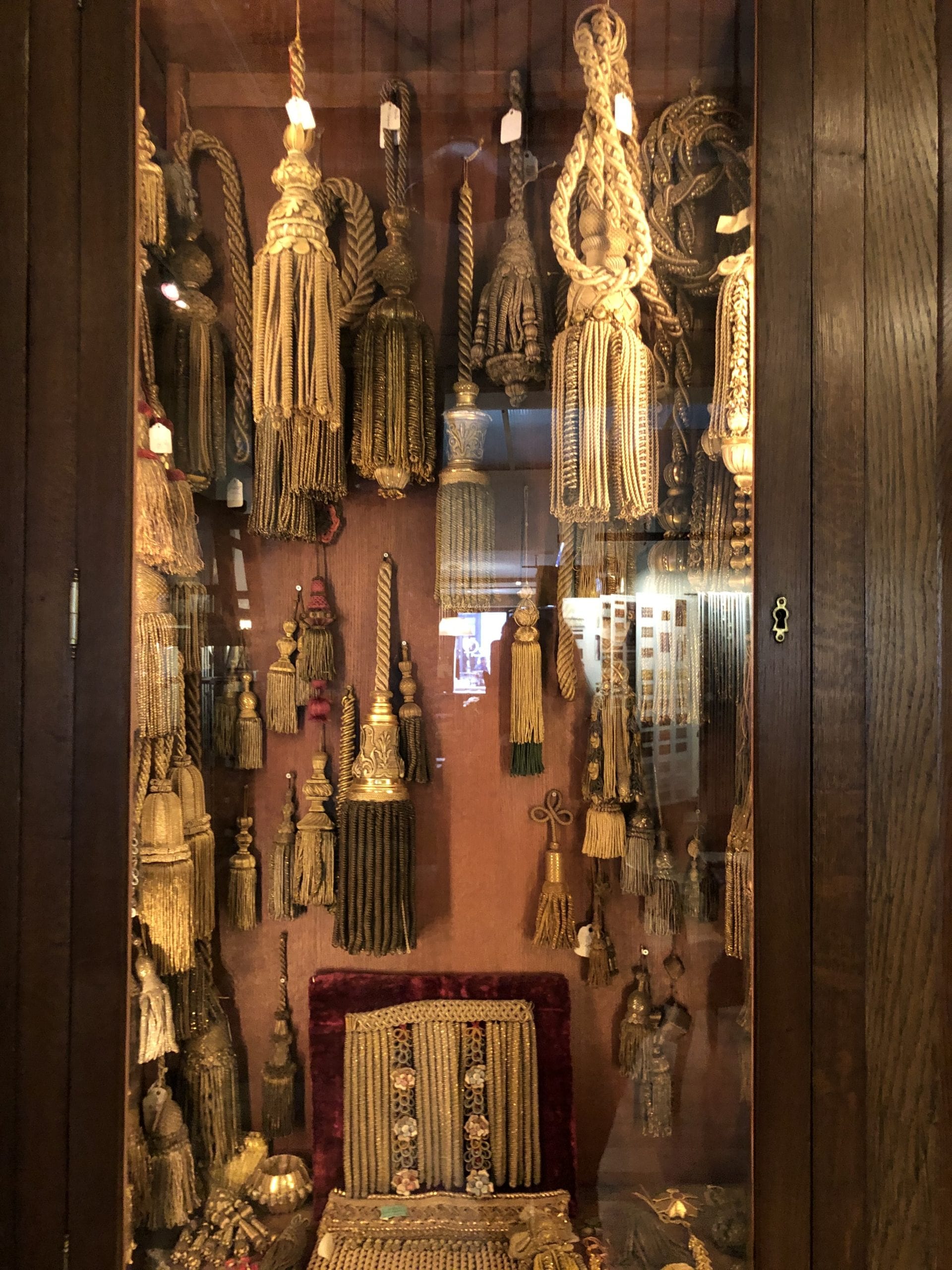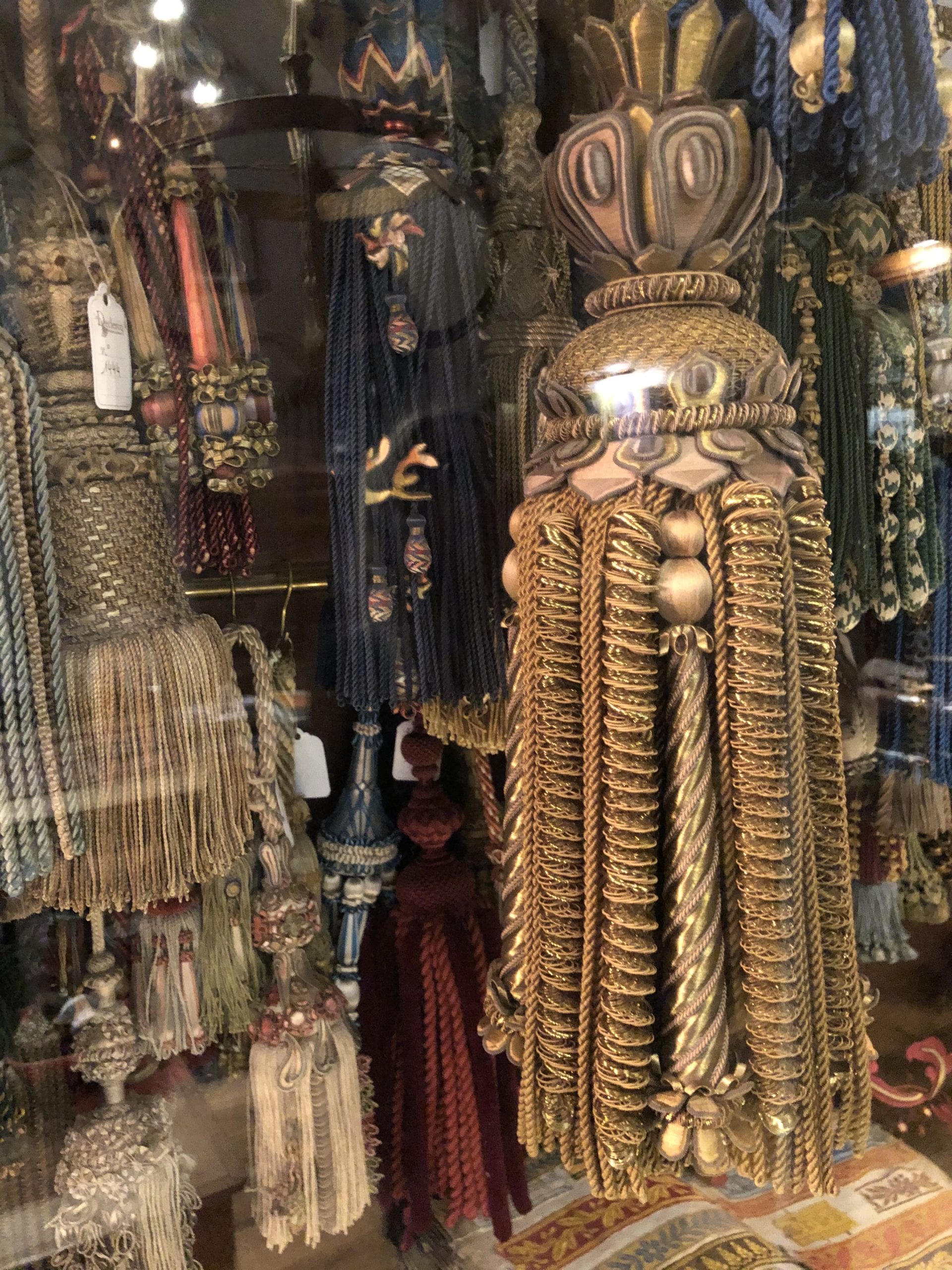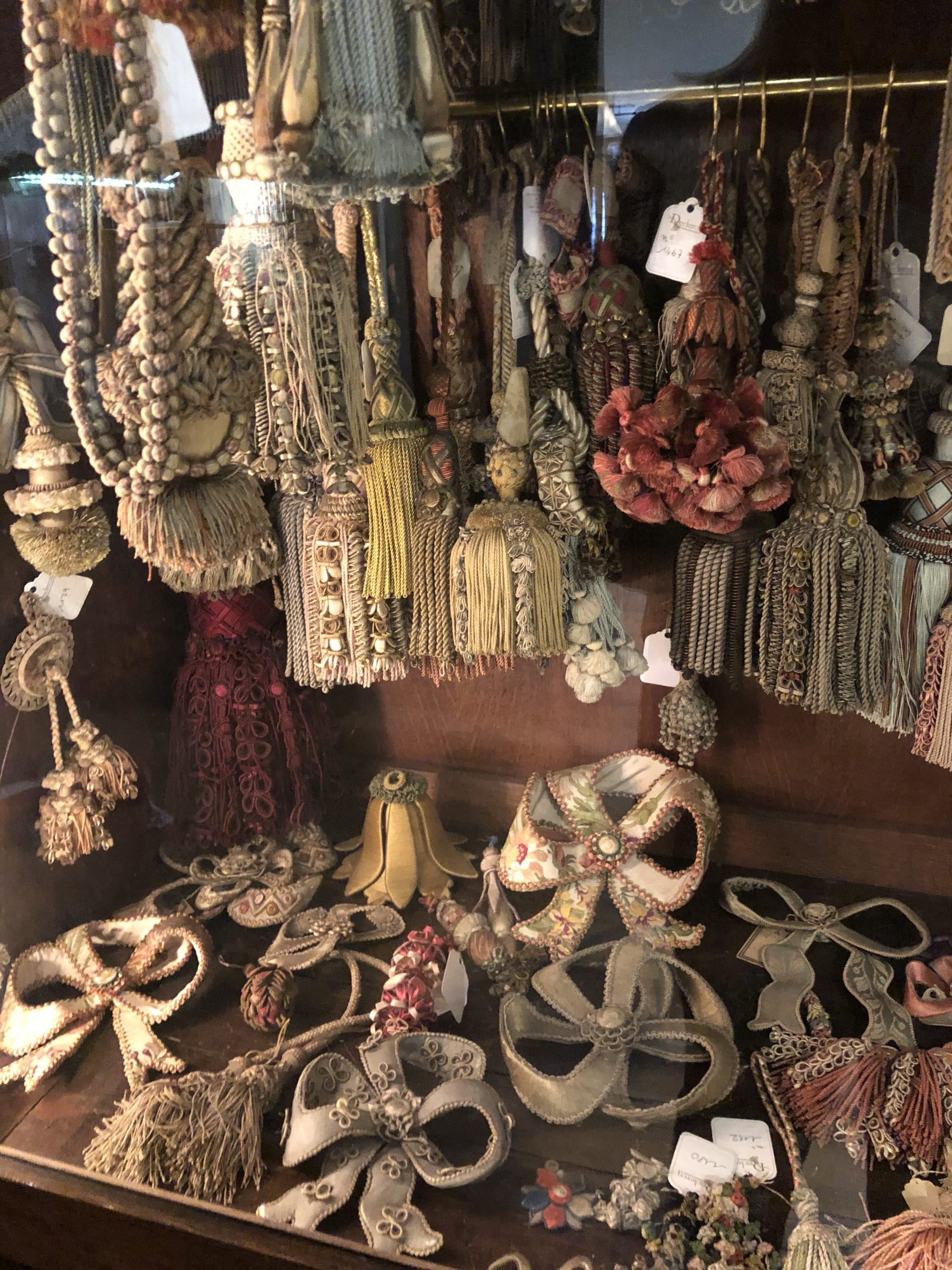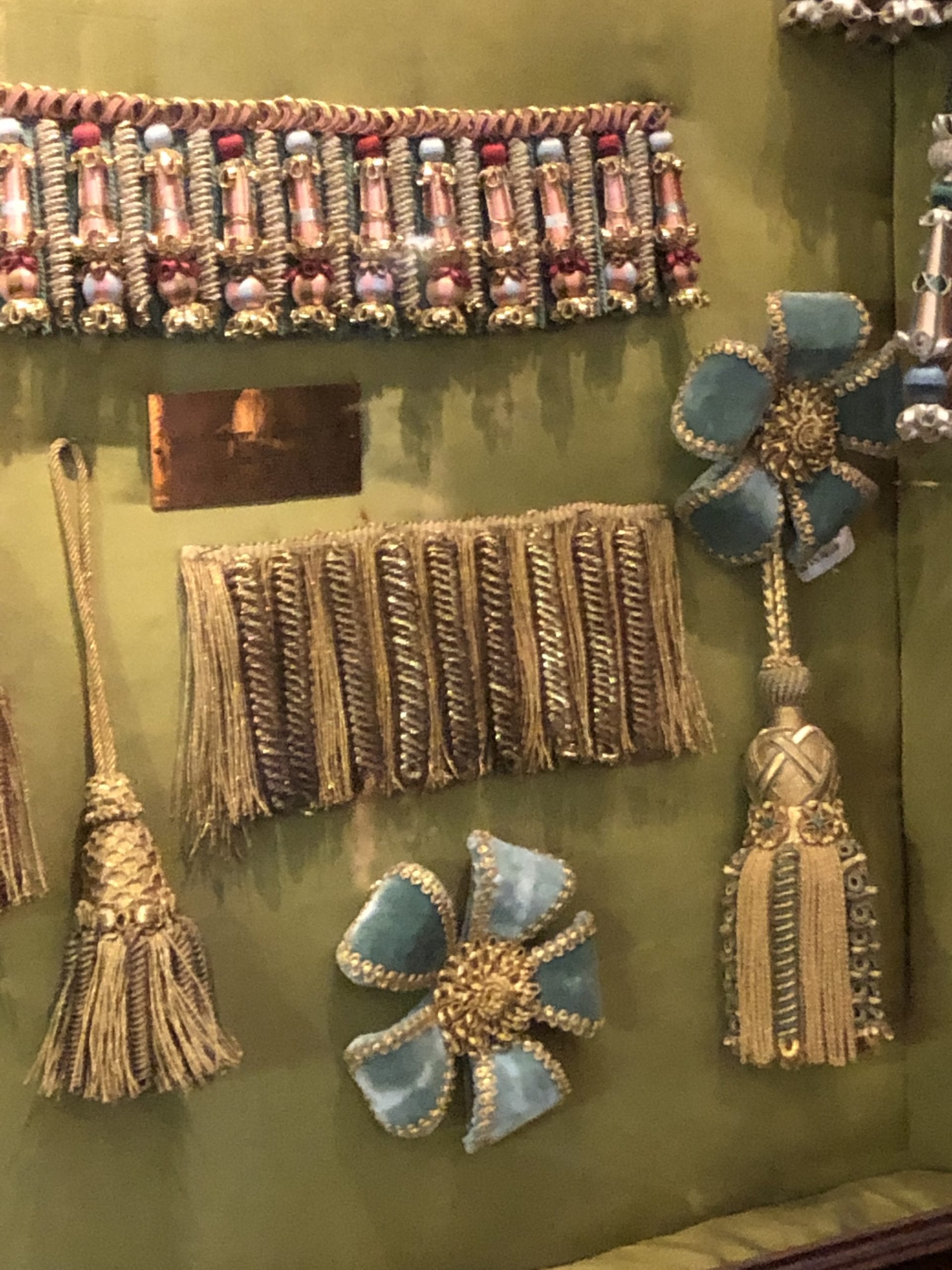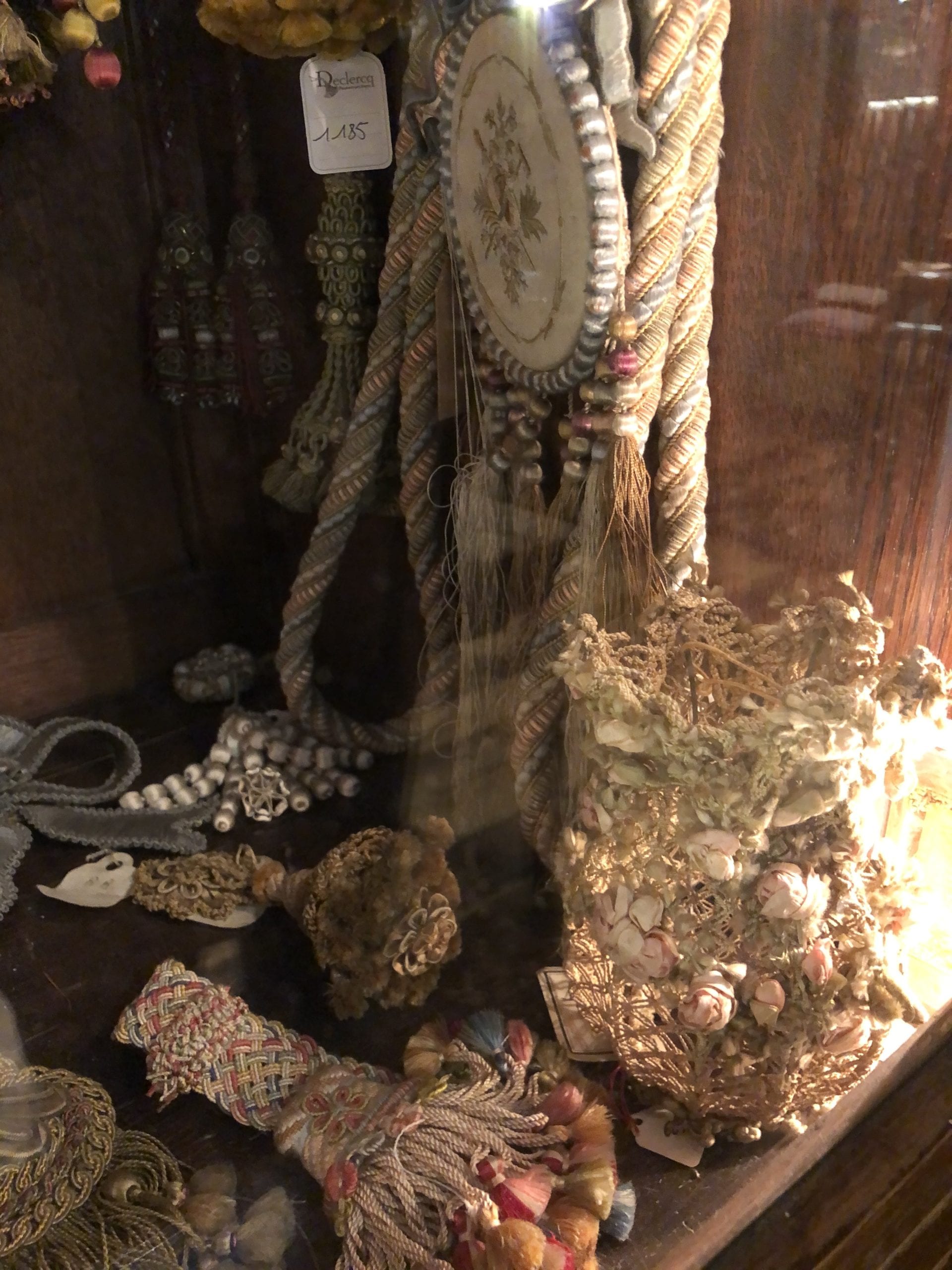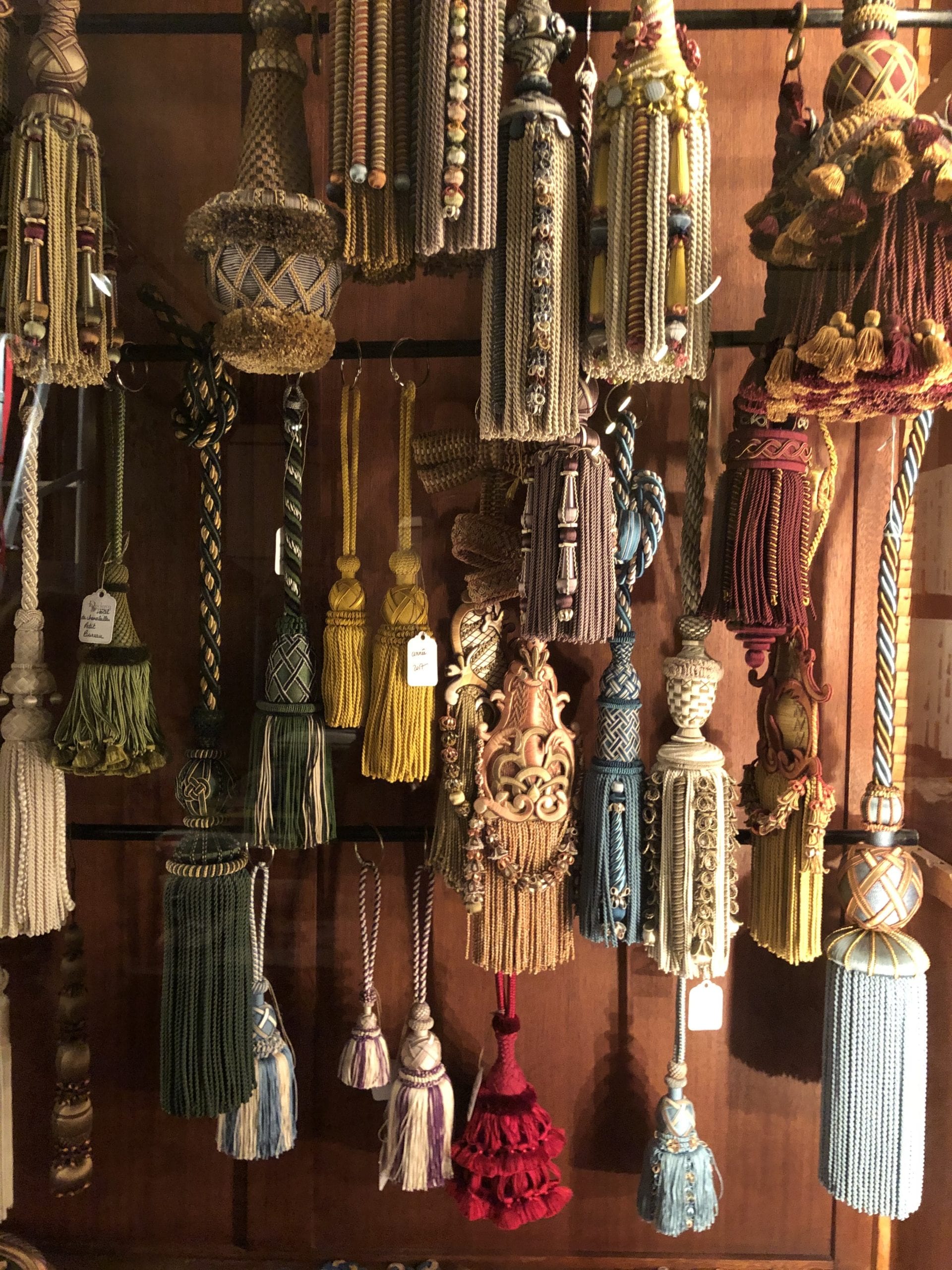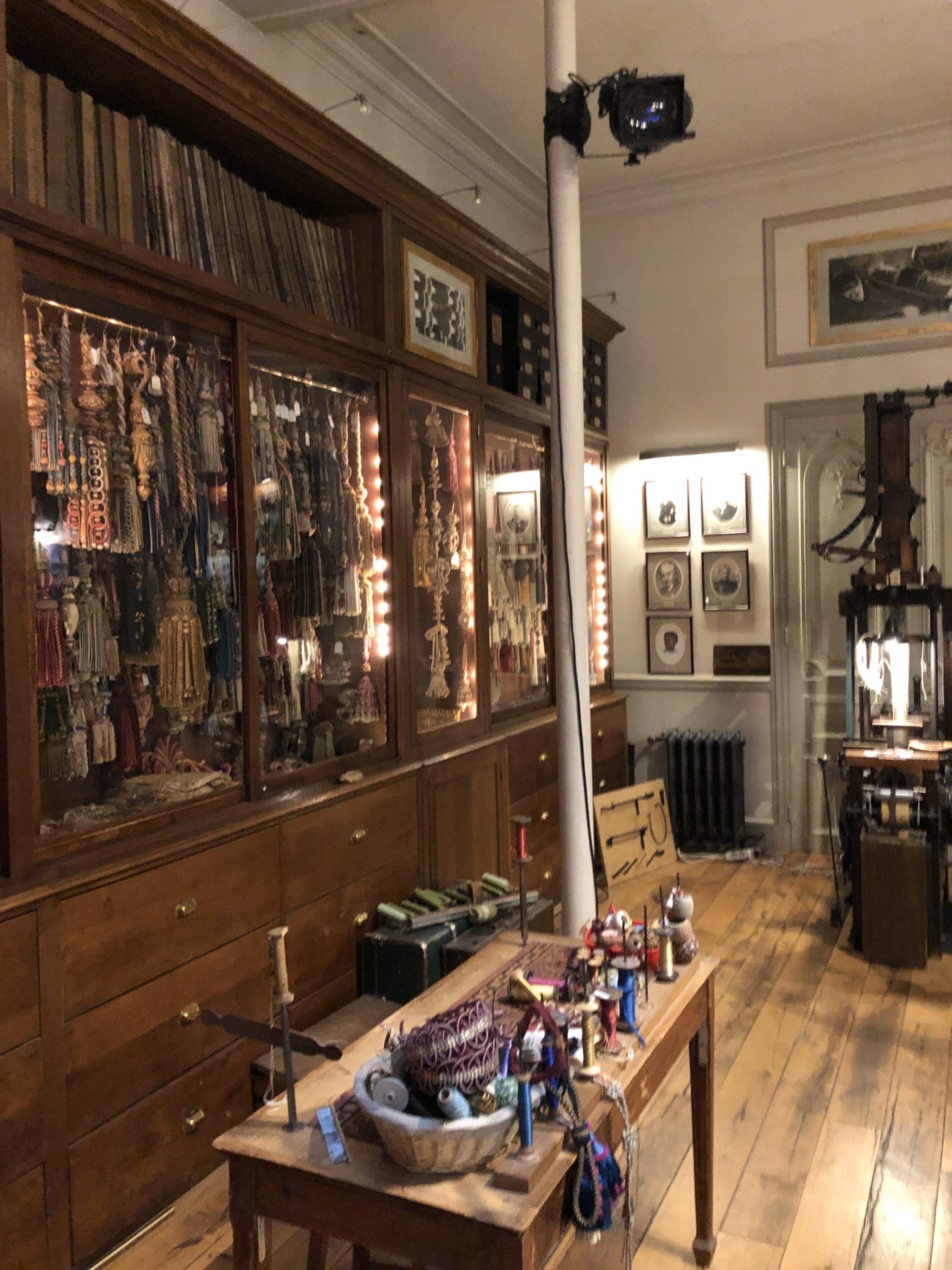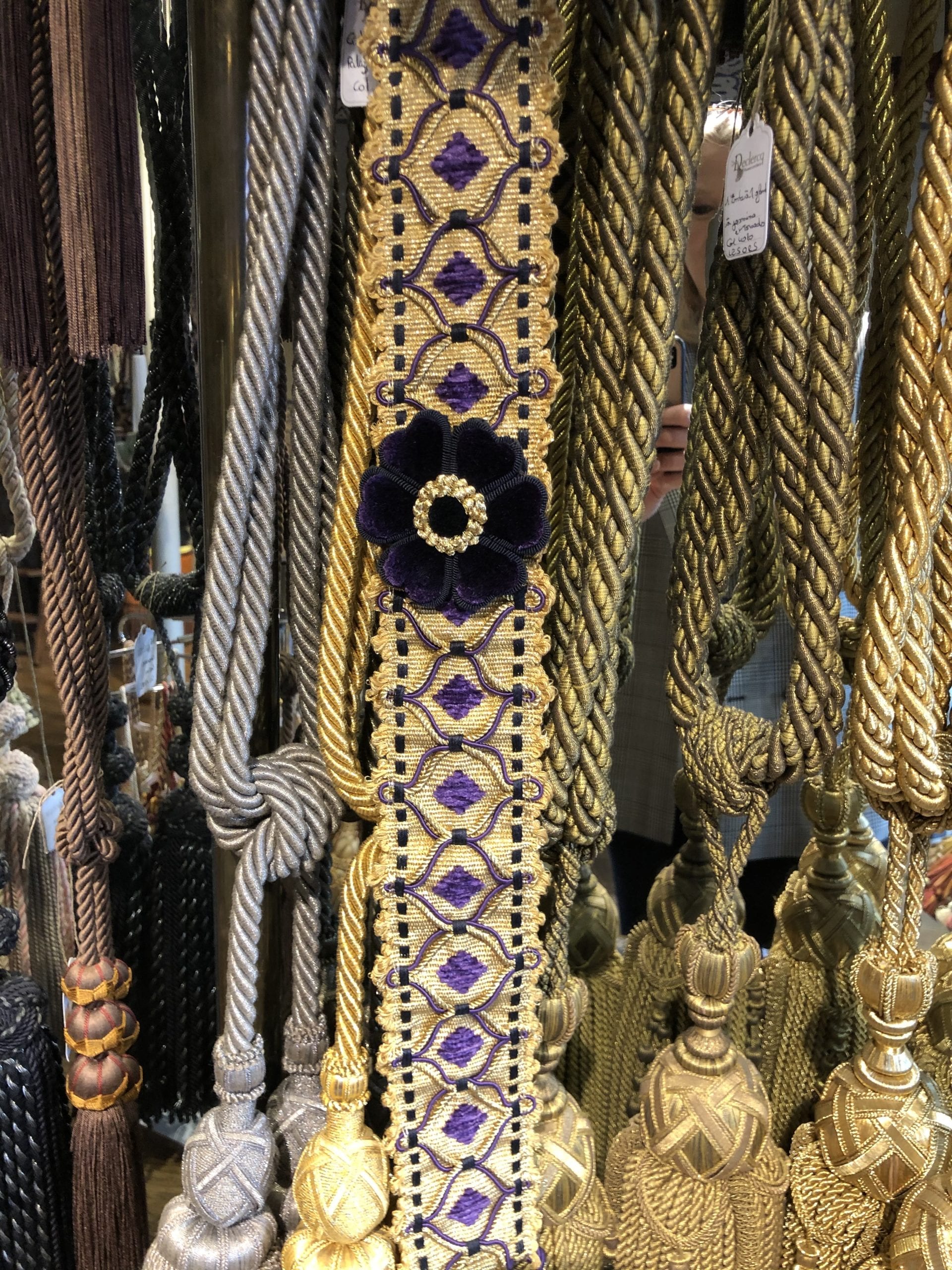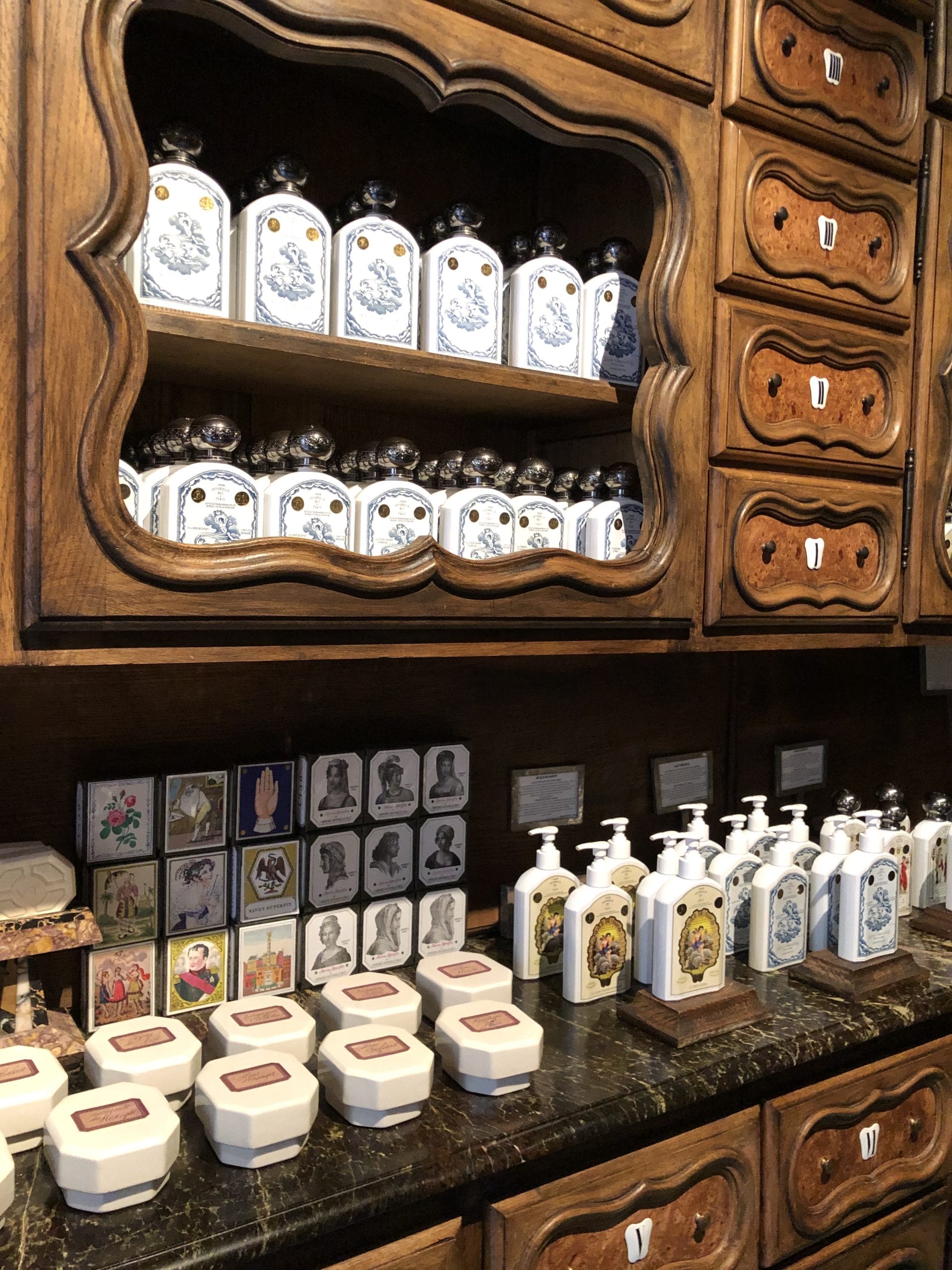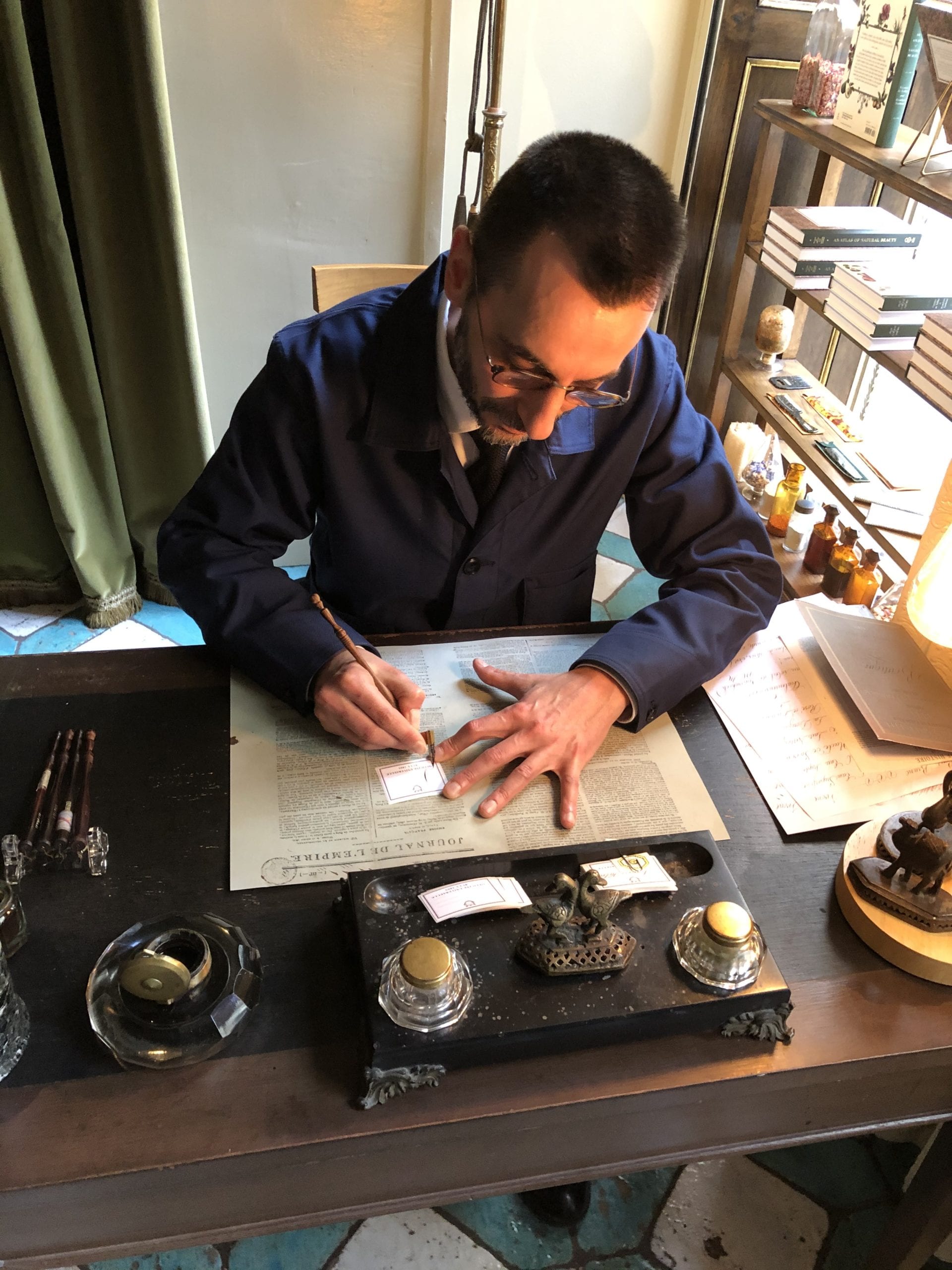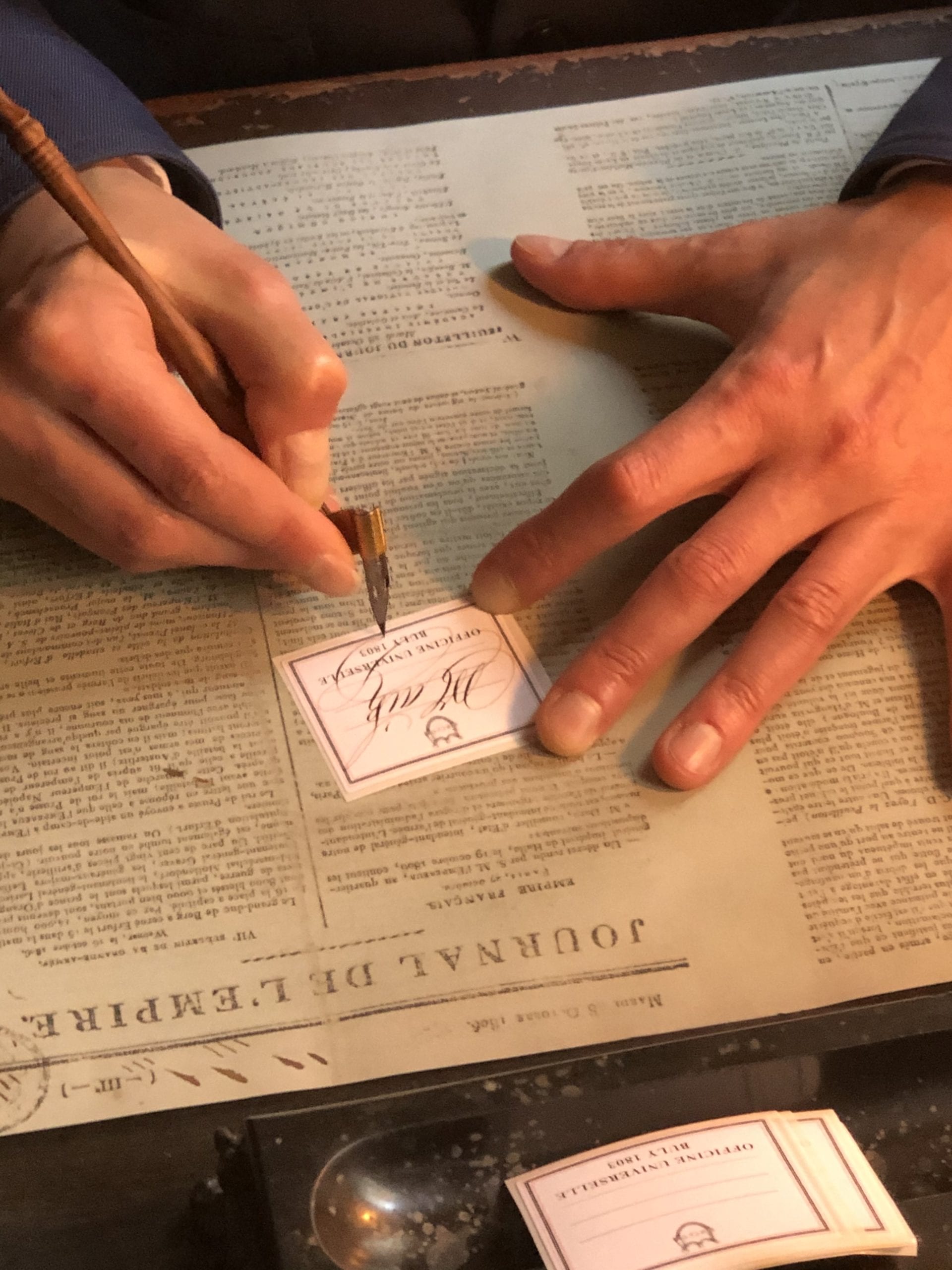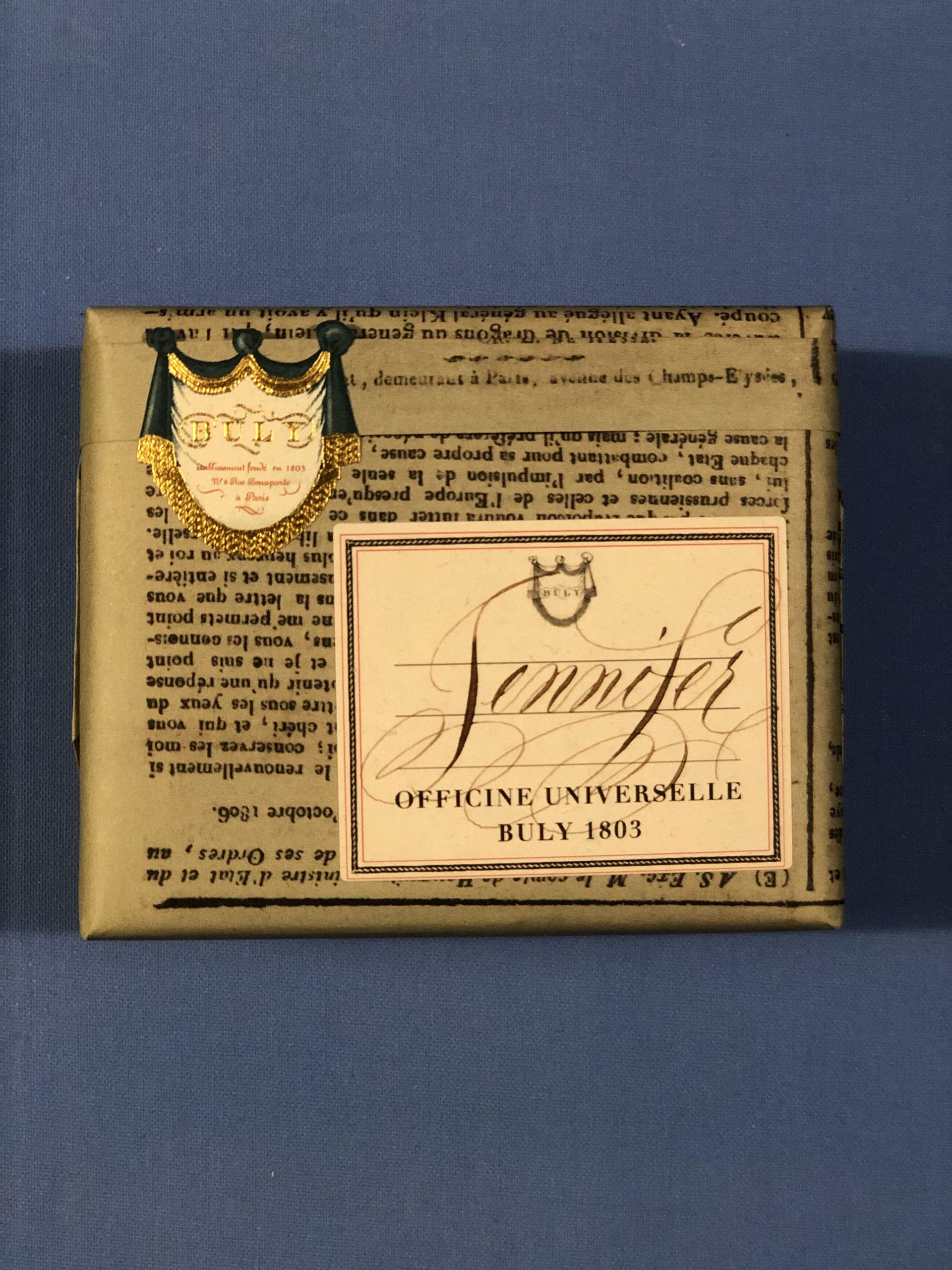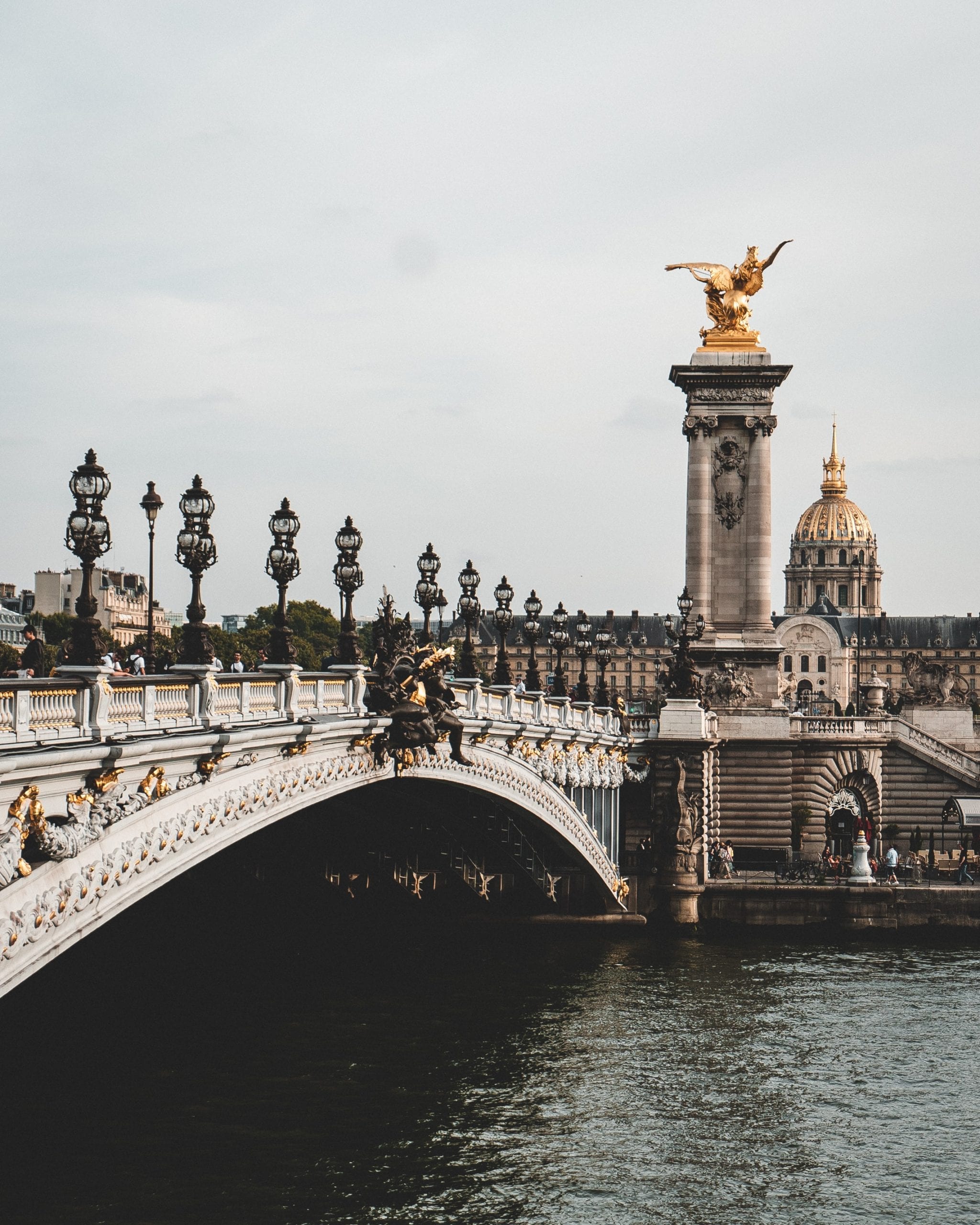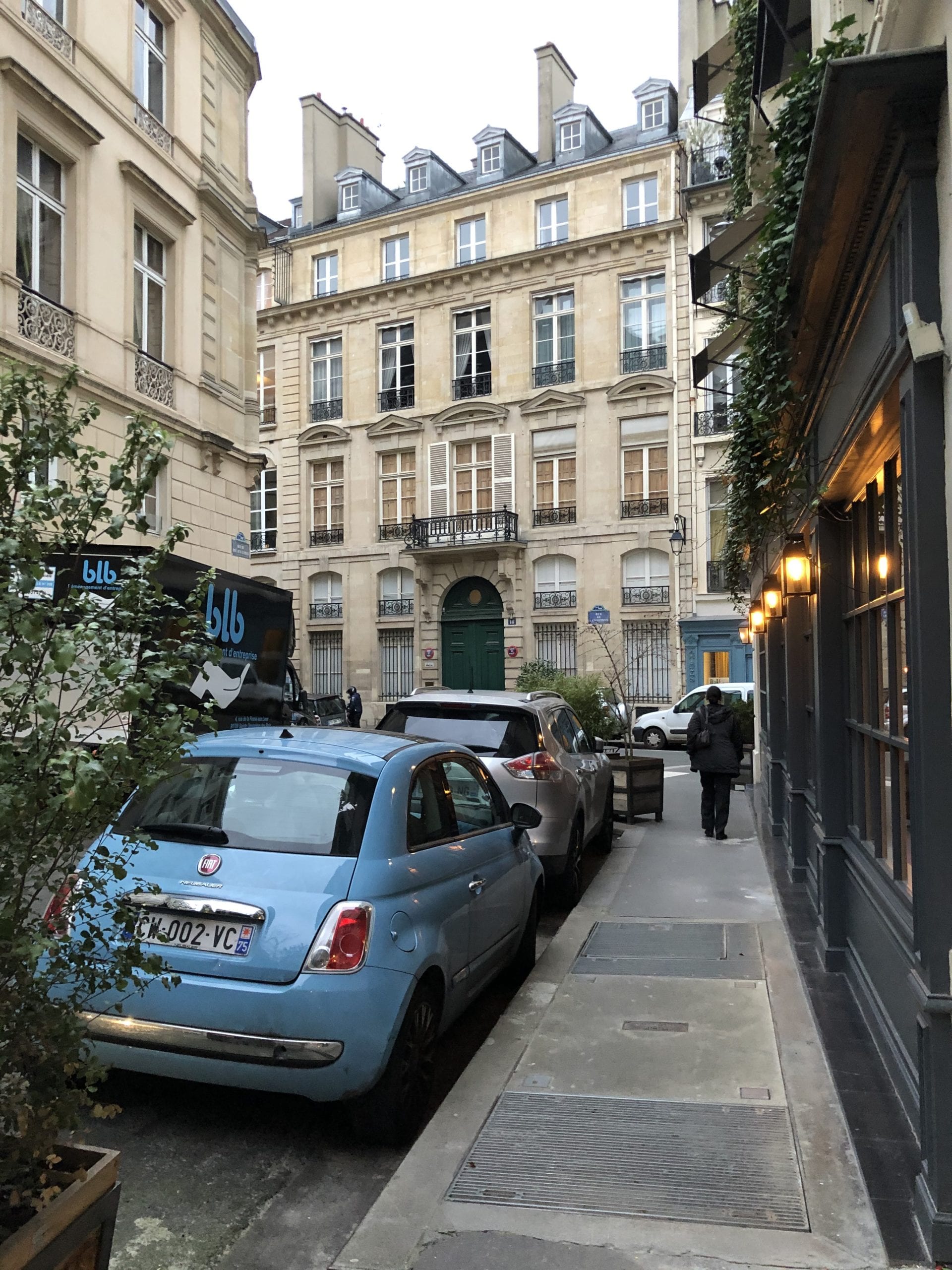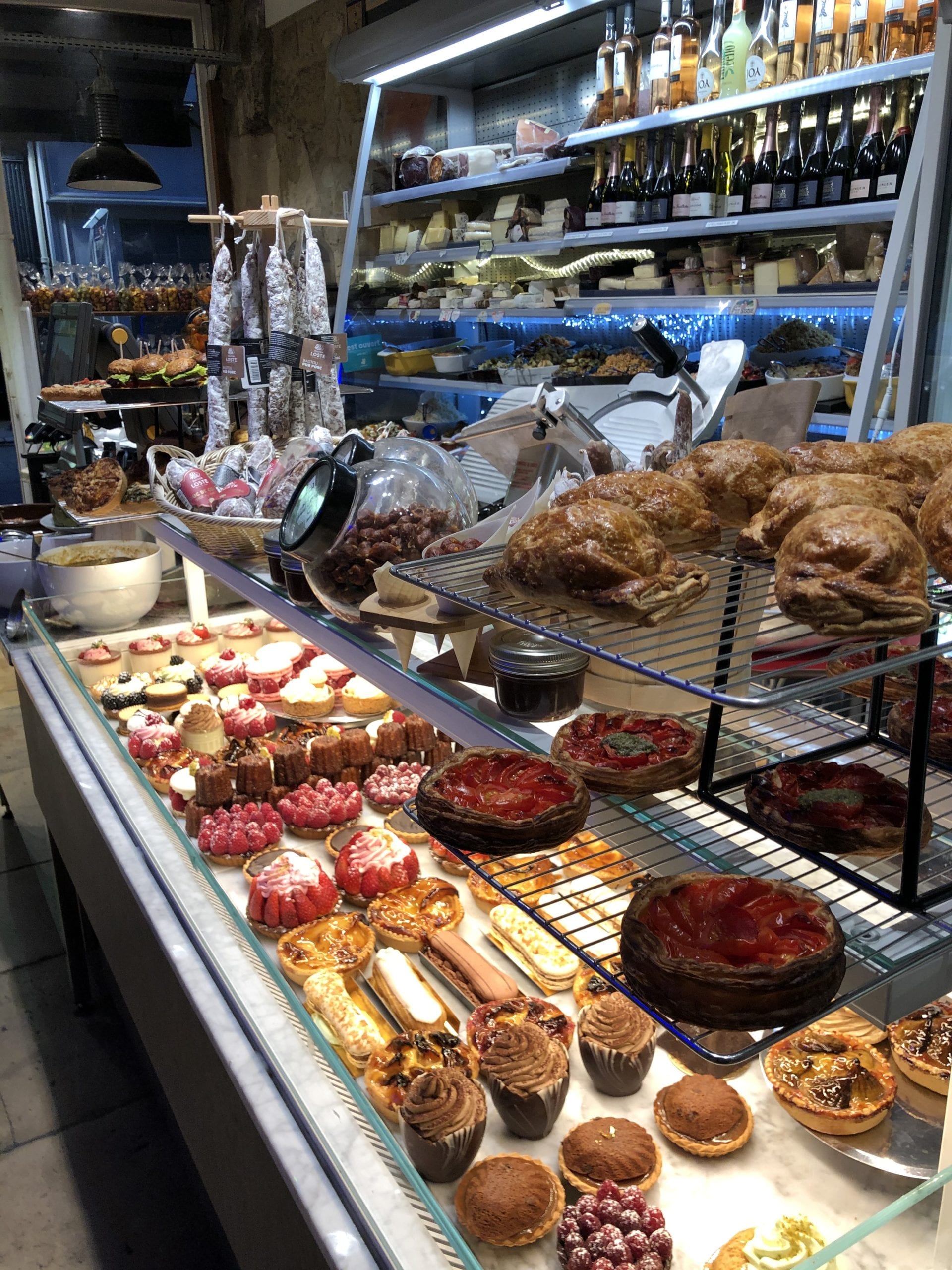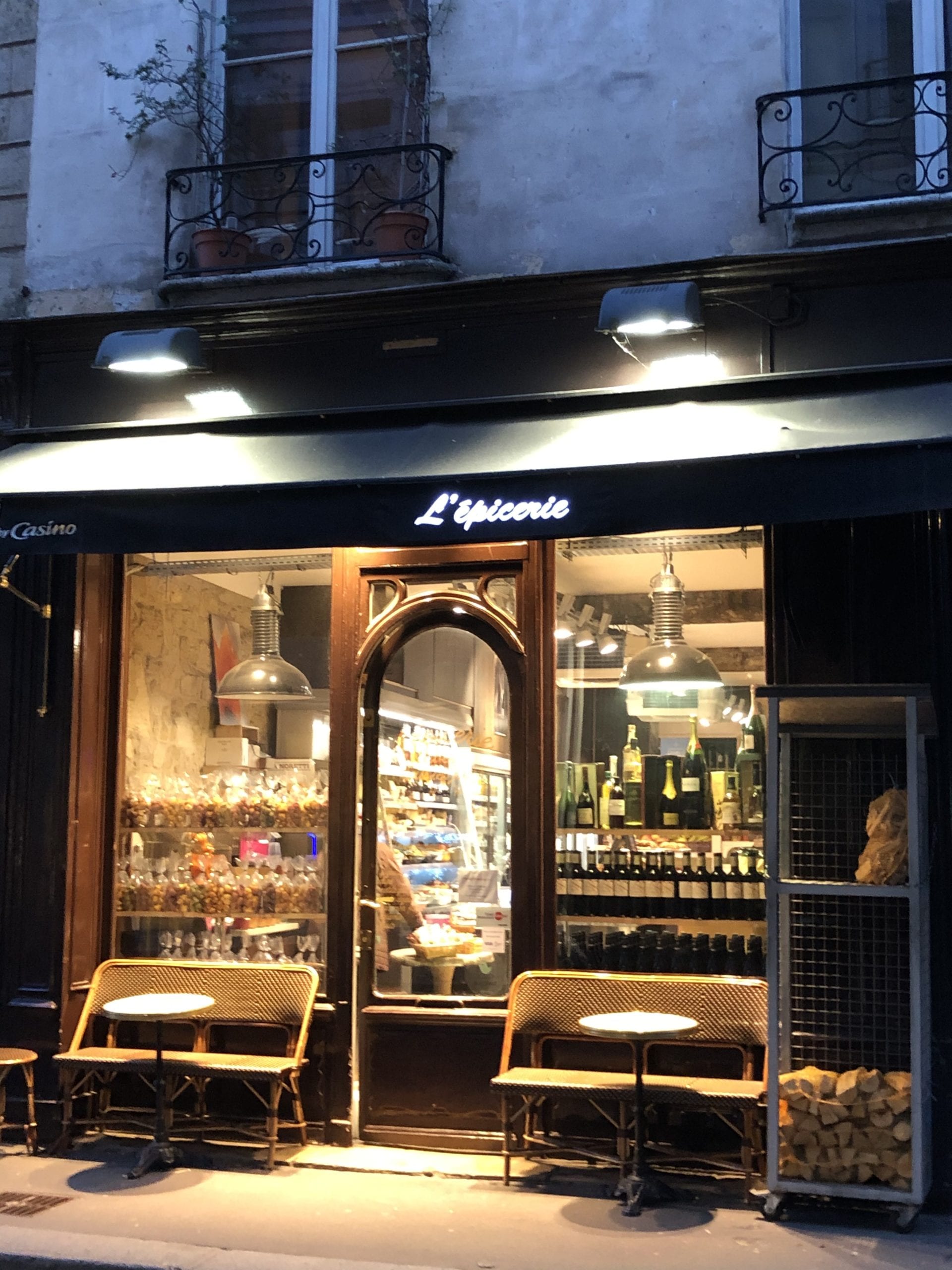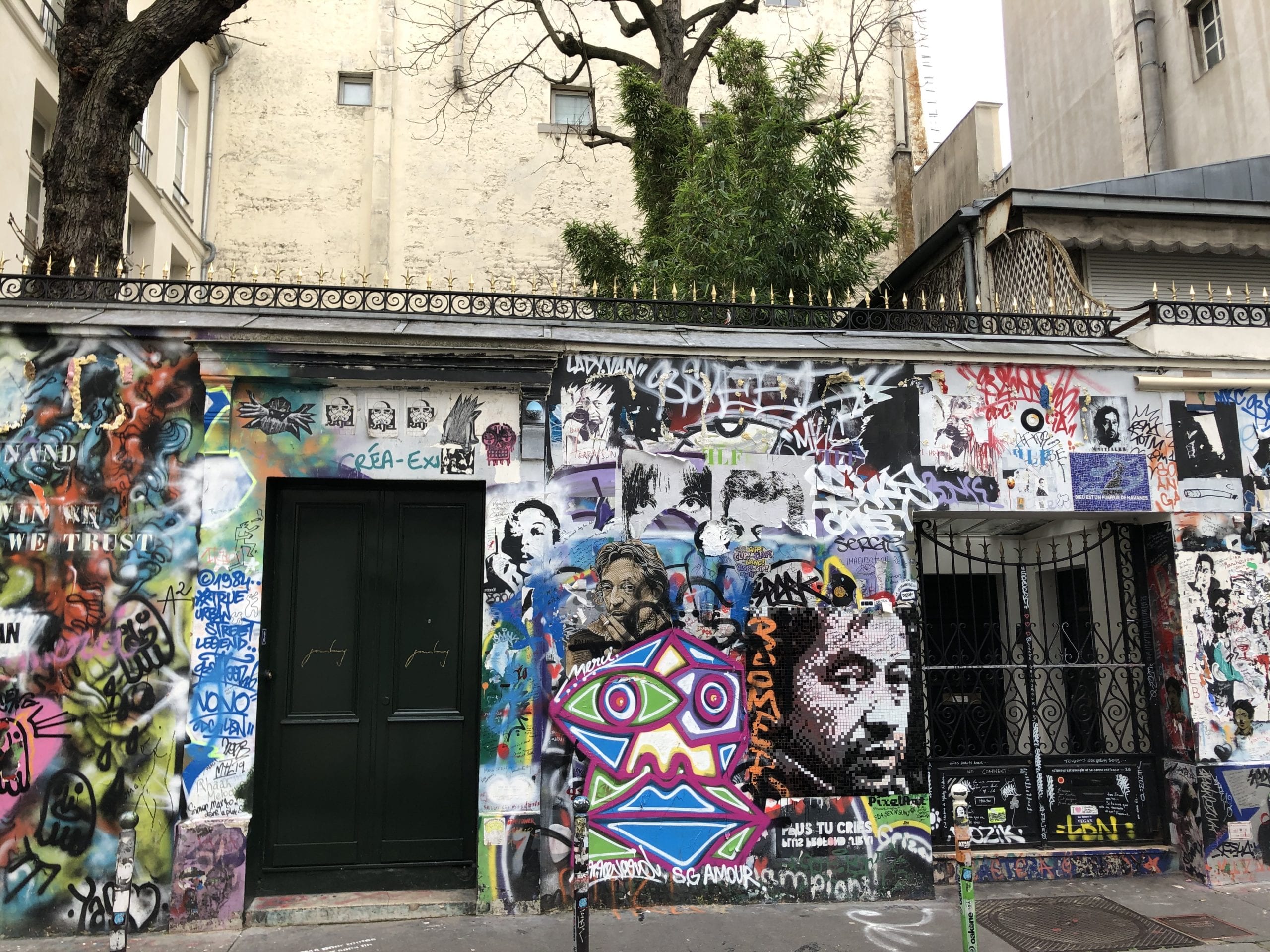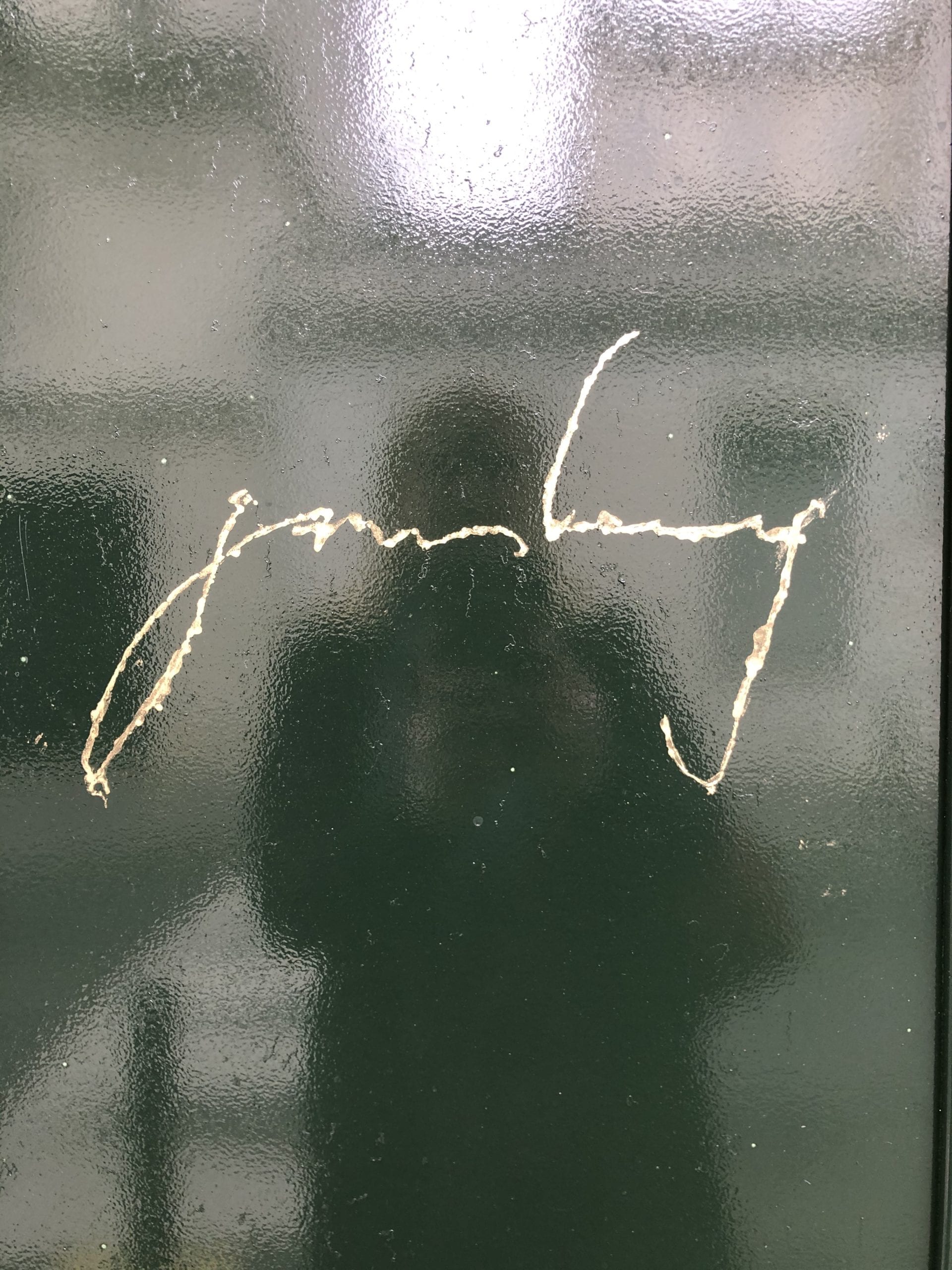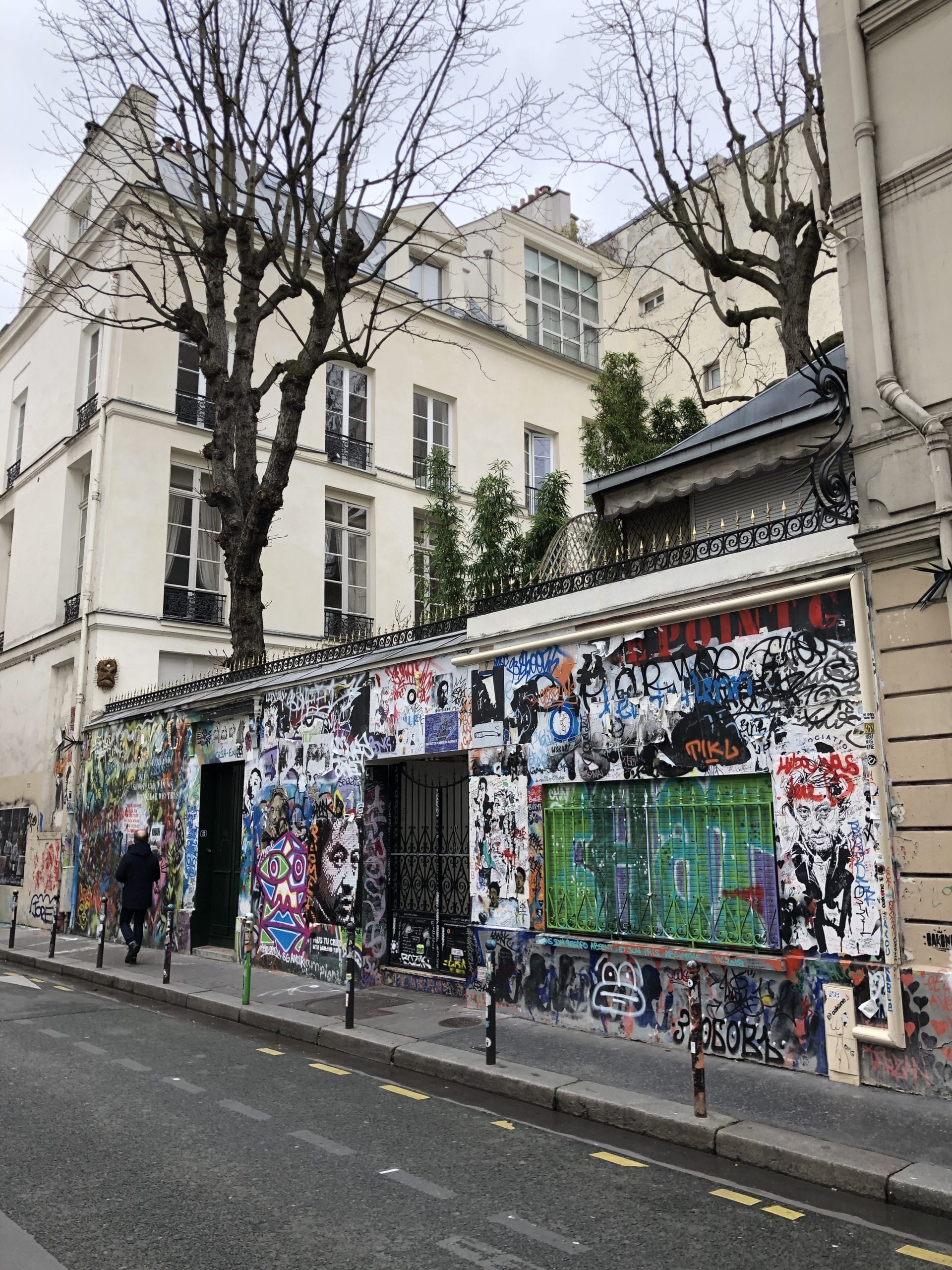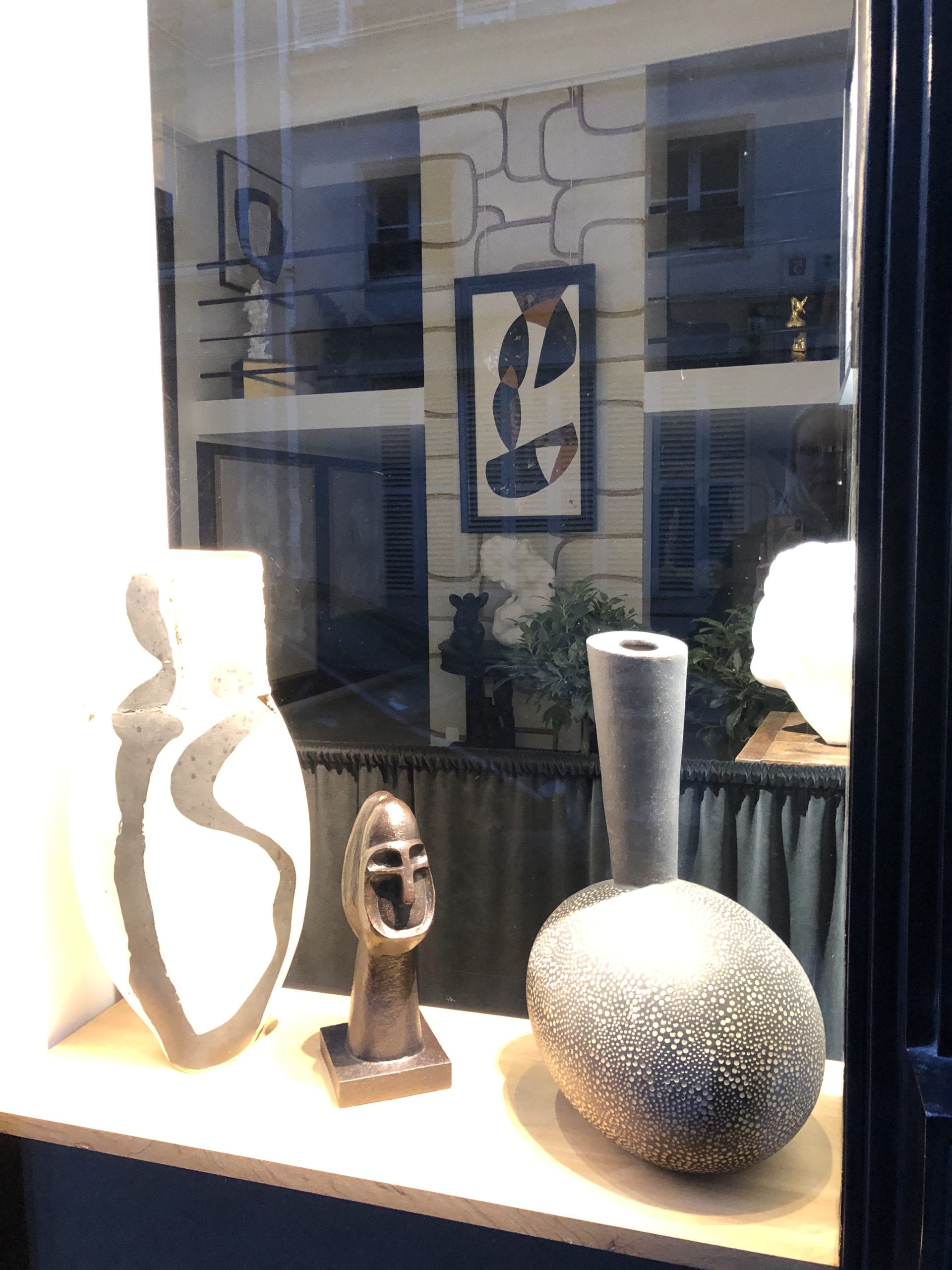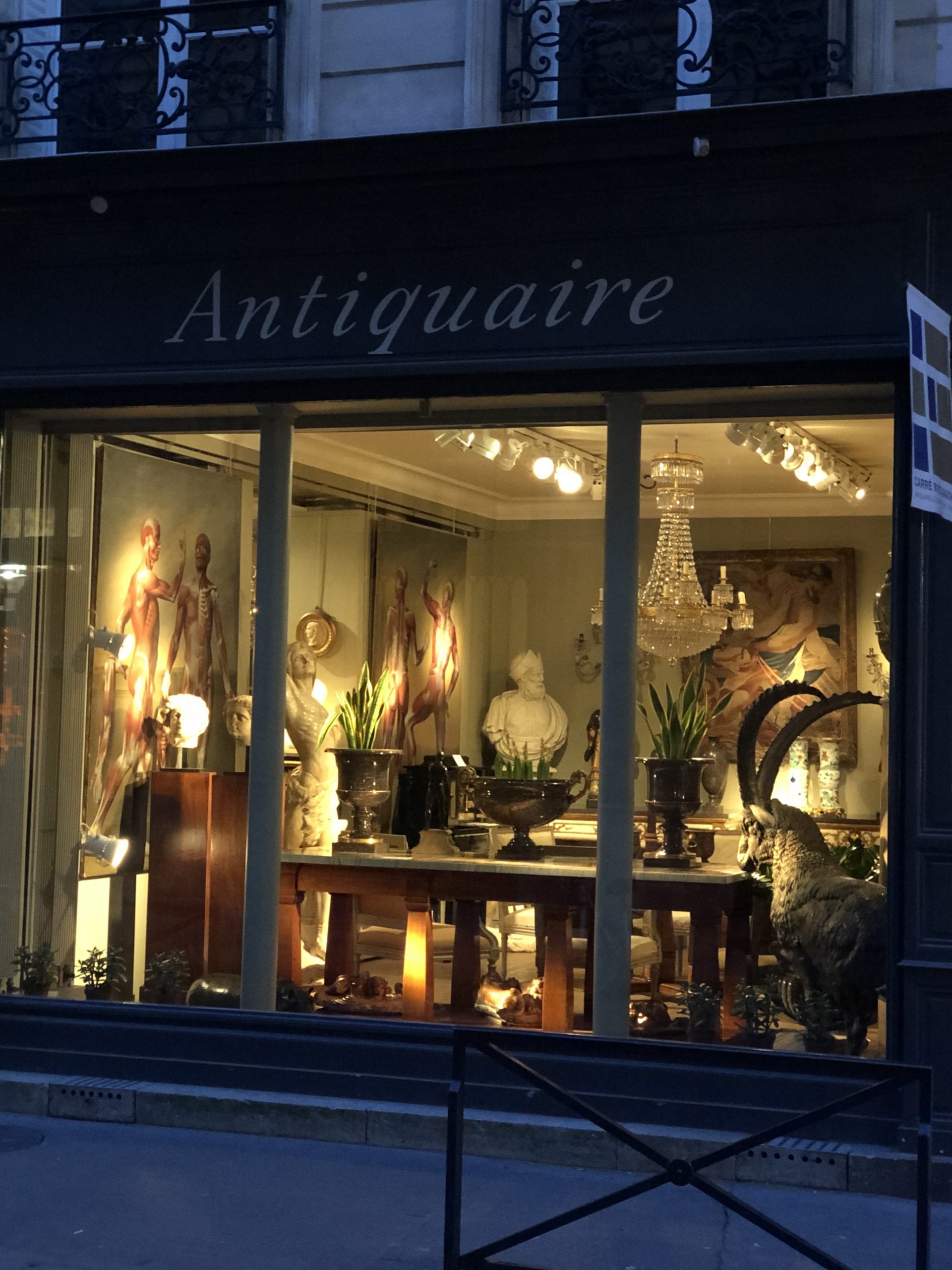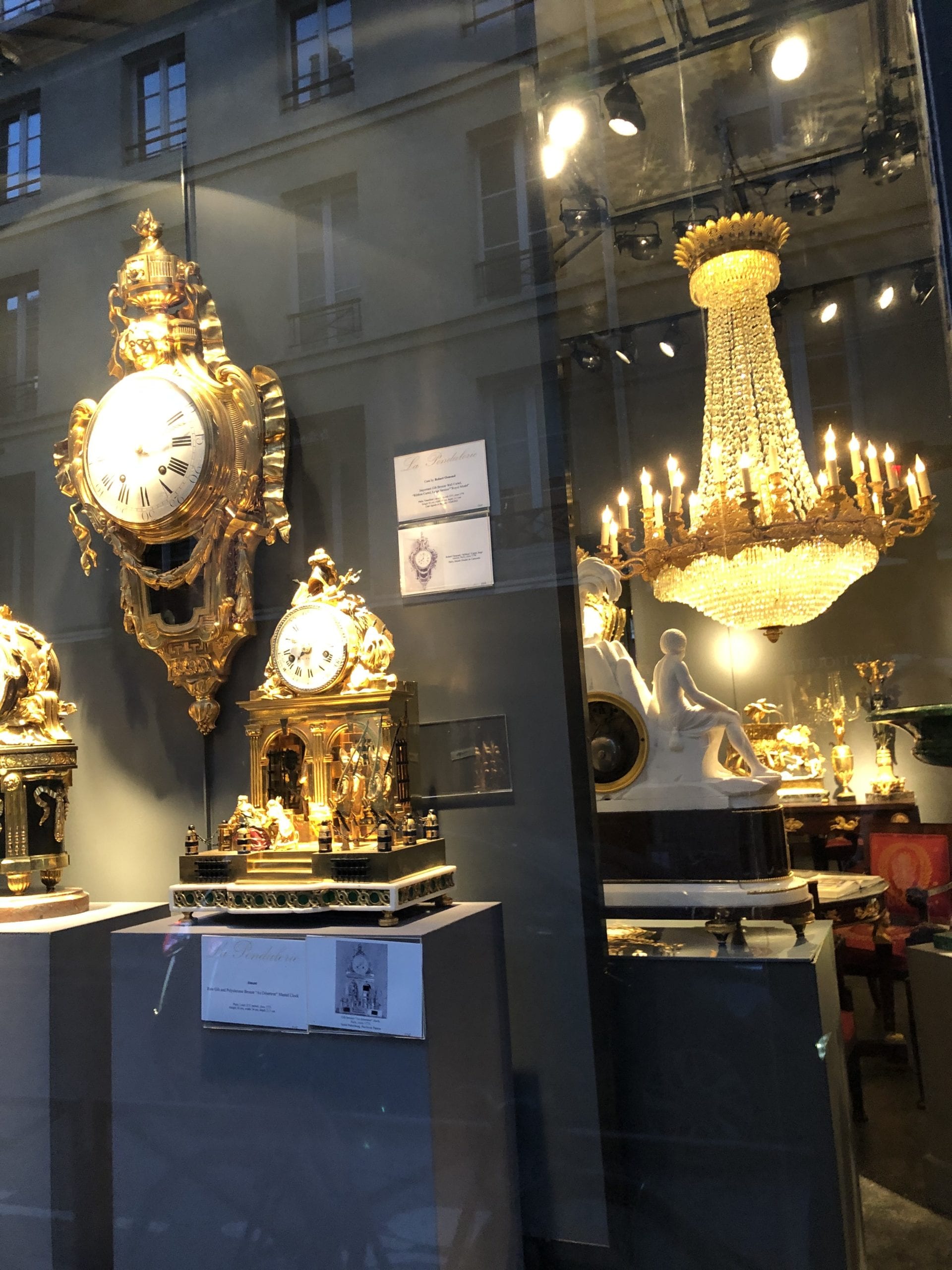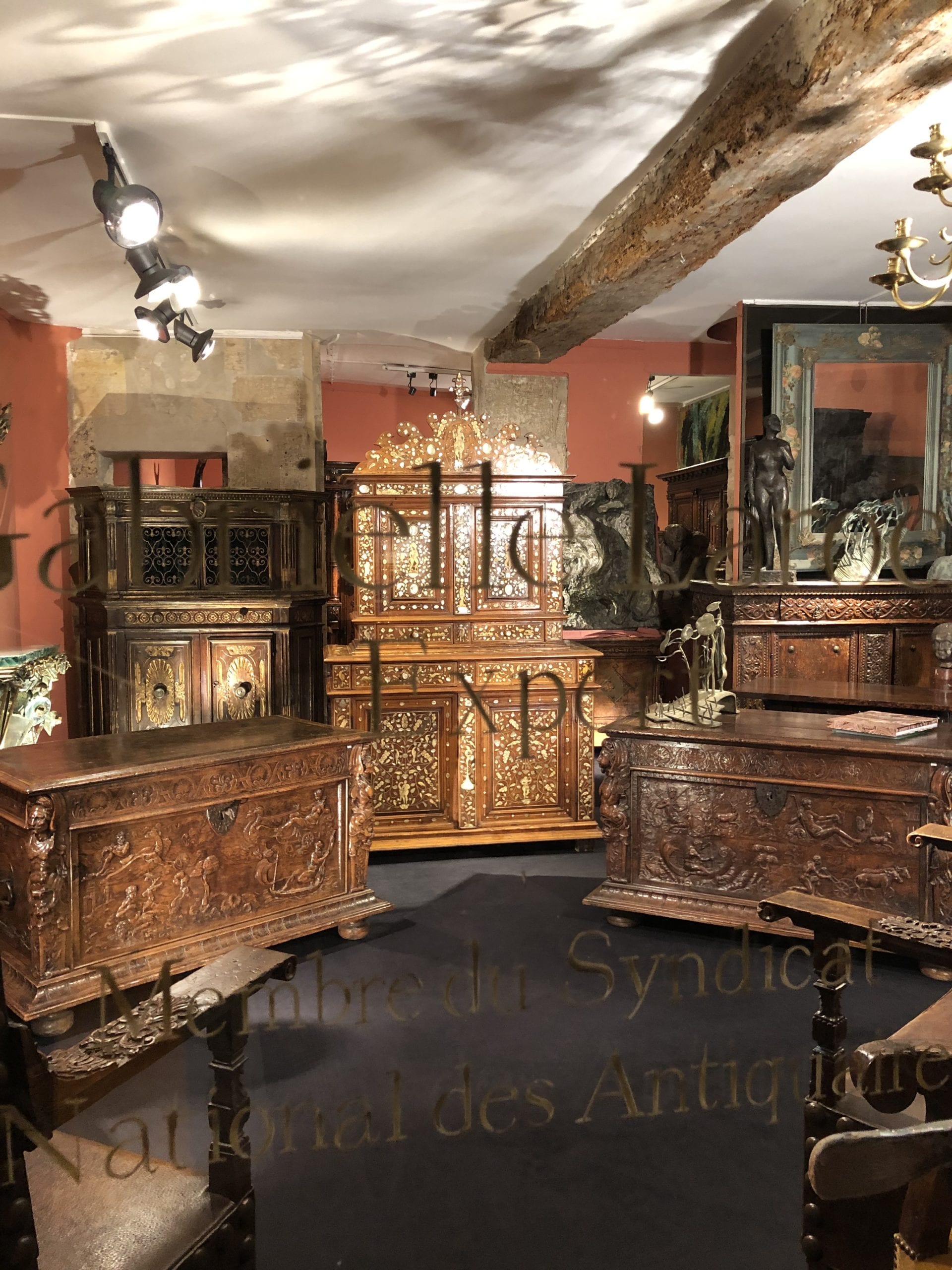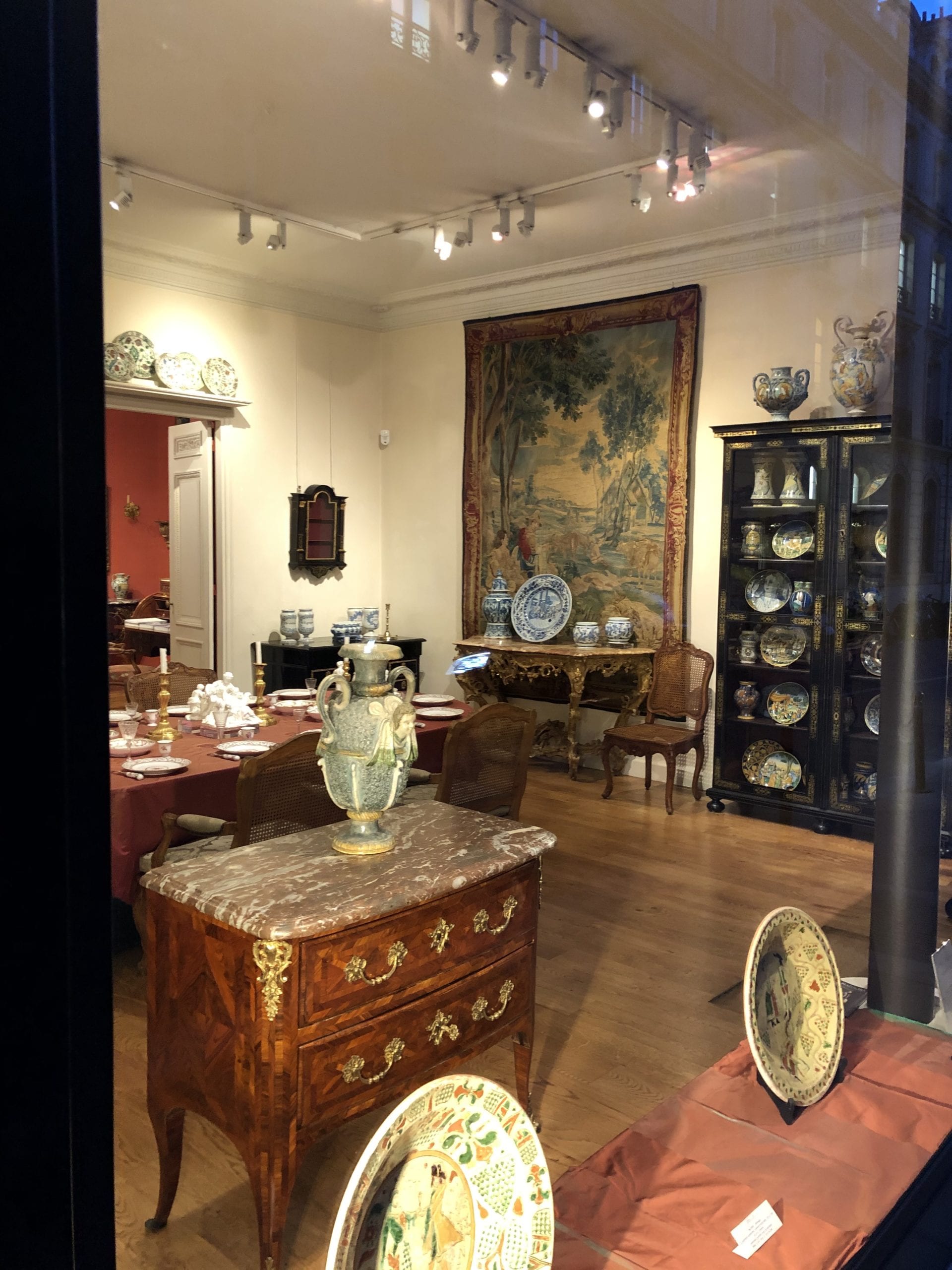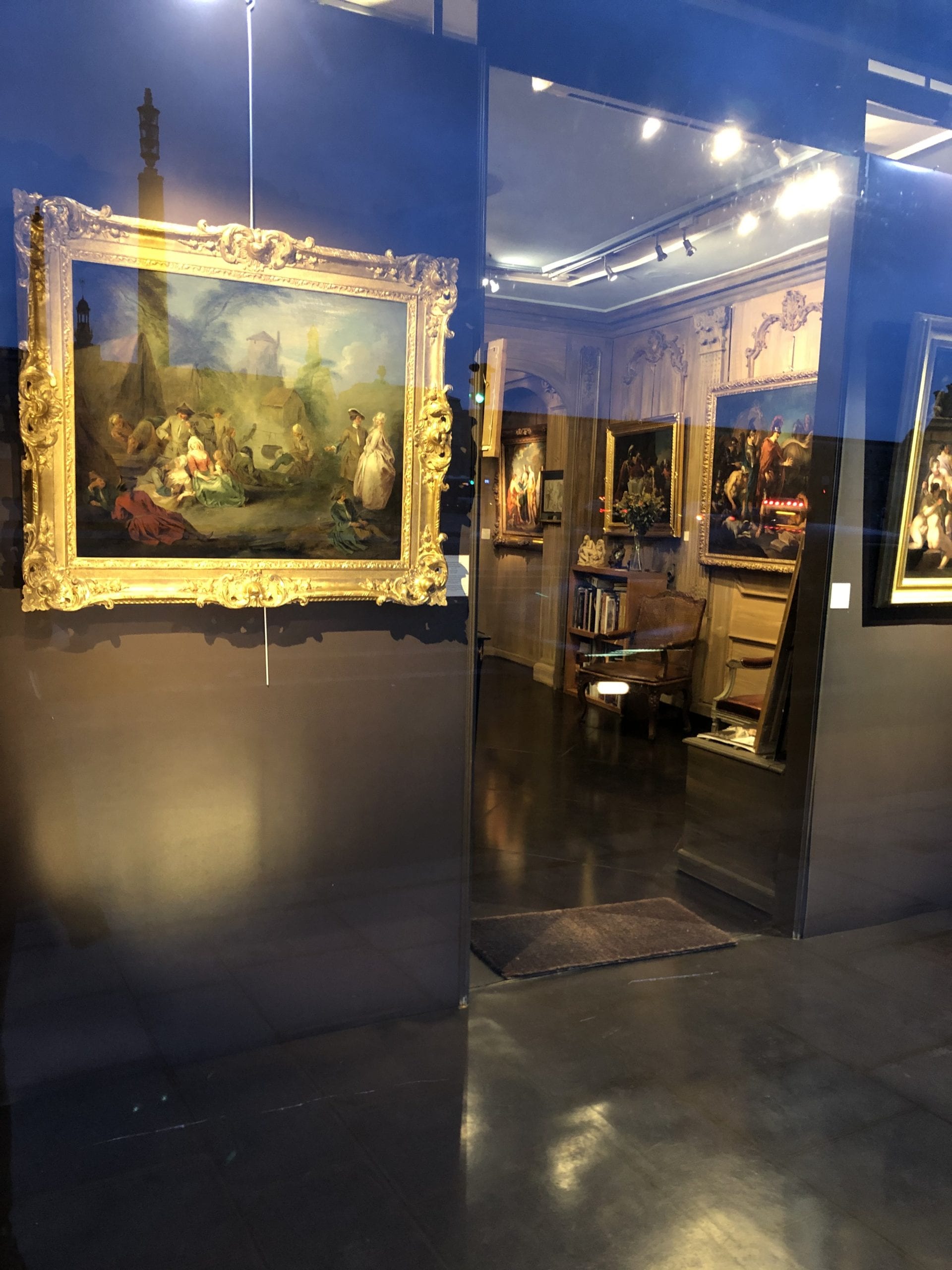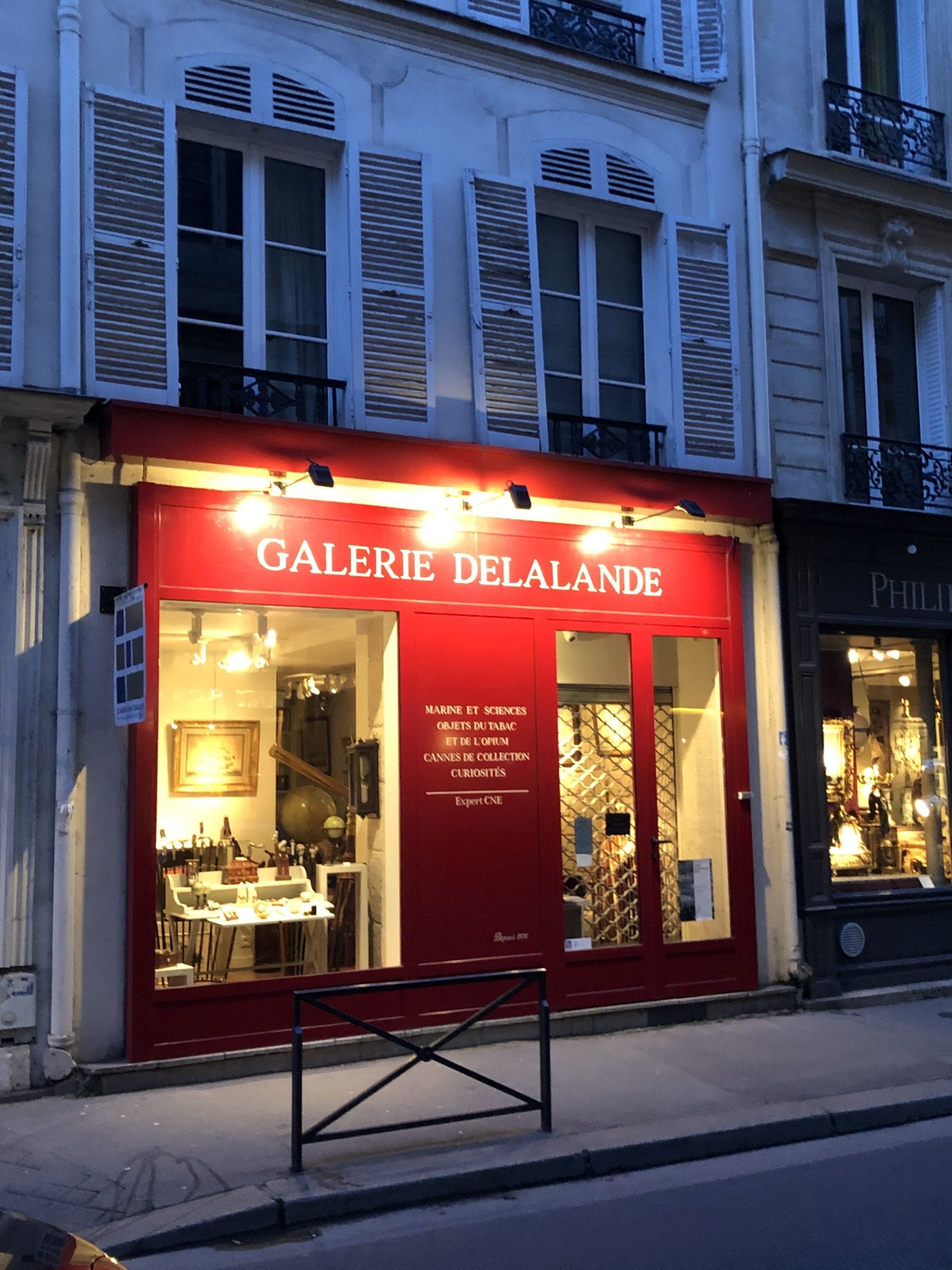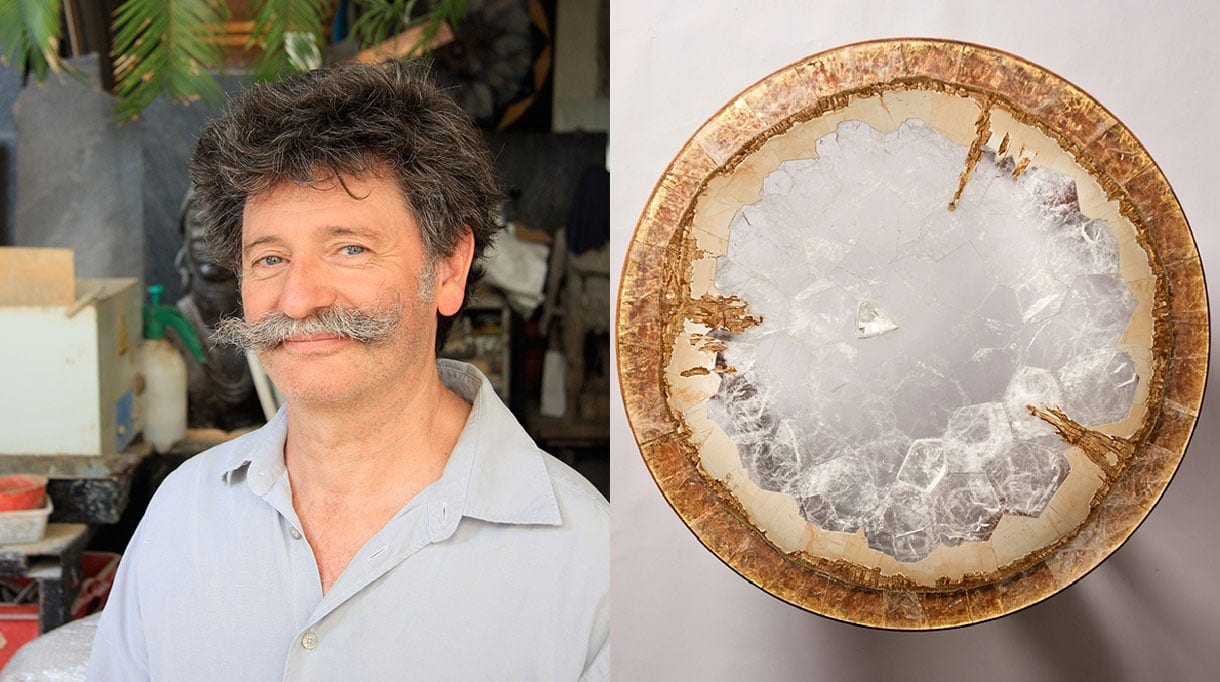Paris on my mind by Jennifer Gyr - Day 4
By Jennifer Gyr
I fell in love with Paris when as a teenager I was watching Audrey Hepburn swan through the ville lumière in the movie “Funny Face”. Over the years I have been so lucky to make many trips to this enchanted city with friends and family. My trip in late February was the first time I was in Paris by myself with my limited French vocabulary of “Bonjour”, “Merci” and “Au Revoir” (which even then I would speak in a whisper so that my Southern accent wouldn’t decimate the beauty of the language).
What a magical week it would be. As Audrey said so perfectly, “Paris is always a good idea”!
Today I am off to see another one of our partners, Declercq Passementiers. I am so looking forward to meeting Margot Declercq, who represents the 7th generation of this family and works closely with her father Jerome. The company has been designing and making trimmings and tassels in Paris since 1852. You must go onto their website to see their family tree: It is a testament to a long-standing tradition of passing on their passion, knowledge, artistry and technique through generations.
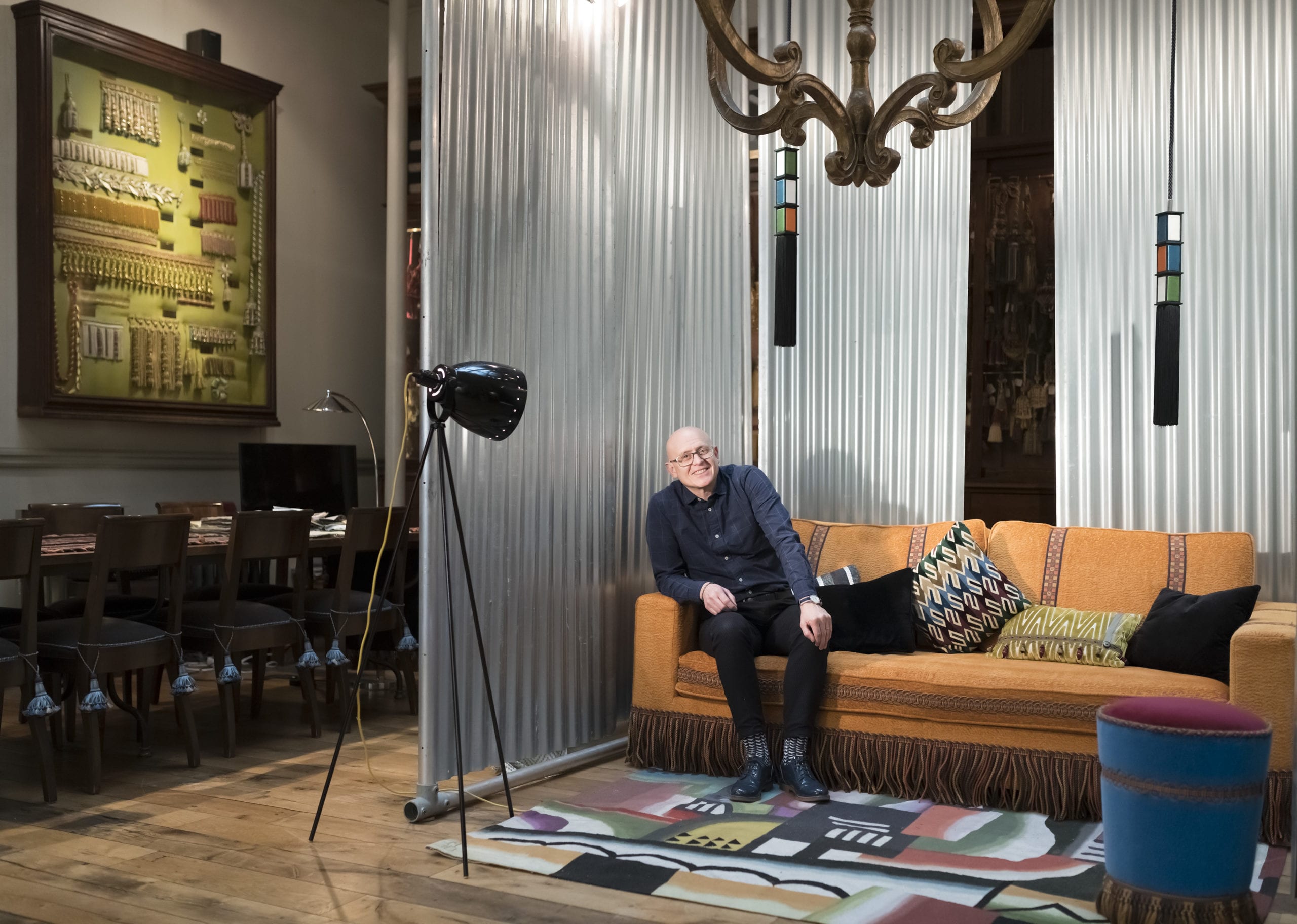
A trip through time and history with Declercq Passementiers
Margot, who is in her late 20s, shows me around her beautiful showroom that is filled floor to ceiling with so many exquisite trimmings and tassels. My eye immediately falls upon two large wooden looms that look like they belong in a museum. I ask about them and Margot jumps on one to show me how it works (the machines are from the late 1800s and are in amazing working condition). The first one requires her to lean forward in a harness, so that she is almost hanging above the threading apparatus. While pushing wooden pedals with her feet, she weaves five different shuttles back and forth between two ribbons to create an intricate pattern along the ribbon. While leaning forward in the harness, stepping down on the pedals to tighten the ribbons between each pass and counting the pattern steps in just a few minutes, she nimbly creates what looks like woven gold into the most beautifully intricate design. I am spell-bound by the process. This not only takes patience and hand-eye coordination, but the right know-how to not miss a beat and to visualize the pattern playing out, as there were neither pattern books nor notes in sight. We then turned to the second 19th century wooden machine. This one is even taller and almost reaches the ceiling. It is fully automated. When Margot turns it on, watching the mechanical gears and cranks moving, and hearing the clanking sound, makes me feel like we are in Thomas Edison’s lab and are turning on the machine that will light the first bulb. Once again, I am amazed to see how the rows of individual different colored threads are being woven into yet another intricate design and turning it into a trimming for a curtain or a piece of furniture
We start discussing how they have to prepare the material before they can even start weaving, from dying the materials to spooling the thread. They even have to hand twist some threads to create the decorative braid that will then be used in the weaving process. Some of the materials are placed on the mechanical looms to create the ribbons and braids, while others are hand-woven to create the complex velvet ribbons, braids and fringes. Margot then shows me a large tassel and I could see the various stages of craftsmanship where everything was done mostly by hand. You really start to think about how design objects are made and who makes them – the artisan at work, years of practice, precision, know-how, passion and dedication. She mentioned that a lot of their employees have worked there 20, 30 and even 40+ years. They create braids, fringes, tassels, rosettes and many other beautiful shapes. It is like making jewels out of thread.
“You really start to think about how design objects are made and who makes them – the artisan at work, years of practice, precision, know-how, passion and dedication“
Speaking of jewels, the next thing I will be seeing is one of the highlights of my trip to Paris. We proceed to a wall of tall wooden glass front cabinets and inside I see the most delicate and refined group of tassels and trimmings, and they belonged to… Marie Antoinette! I feel a sense of awe seeing the light pastel colors and delicate trimmings, which encapsulate her sense of style and personality. I could even imagine her wearing some of the rosettes and fringe pieces in her hair, around her neck or adorning her dresses besides her furniture and curtains and bed. There is even a bouquet of flowers made out of fringes and an extremely delicate looking woven basket with light pink flowers and greenery scattered all around. It looks like a lovely bird’s nest that fell on the forest ground and flowers started growing on it. Do we even think about such detail and artistry when we buy things in our times? Their imagination was so fertile. I then looked at the next cabinet and it felt like a trumpet started playing and everything got bigger and bolder and more masculine and imperial: I was now looking at tassels that were made for Napoleon personally. In 1972, Declercq acquired a very old trimmings company from the 18th century, which included the archives of Marie Antoinette, Napoleon and Louis XVI, as well as old pattern books, which they now have on their library shelves. Louis XVI’s and Napoleon’s were impressive to see, but Marie Antoinette’s really made a lasting impression on me. Margot pointed out a trim that belonged to her, and again it had the most delicate, small flowers, bows and greenery tumbling off of a pale, woven ribbon. She told me that recently a Japanese couple asked Declercq to recreate this trim, and they used it all over their bedroom as they wanted to feel like Marie Antoinette. We then passed by a mannequin that they had adorned with a makeshift dress made of tassels and trimmings and it got me thinking that this beautiful craft doesn’t have to be just for your home. Let your imagination carry you away.
As I was leaving and saying my goodbyes, a large piece of trim hanging near the door caught my eye. Purple is my favorite color, and I loved how regal it looked so I asked her about it. Margot gave me a big smile and said, “My father designed it and he named it after me”. The family legacy lives on.
A lovely stop at Buly 1803
I headed back to the 6th and 7th to visit two of my favorite stores that I always go to every time I am in Paris.
I walk across the Pont Neuf and enter another world at l’Officine Universelle Buly (also known as Buly 1803) on Rue Bonaparte in the 6th. This is one of the most unique beauty boutiques in Paris (and perhaps the world). Their products, packaging, store design, history and even the store clerks make this such a special experience. I open the large glass door and am immediately transported back in time to an 18th century apothecary and I feel like I have stepped into a Visconti meets Wes Anderson film. There is such attention to detail from the grand noble wooden cabinets filled with the most beautiful array of lotions and potions flanked by rich marble countertops where you can sample the products. I walk over the worn blue-green tiles with the Buly “coat of arms” and feel like I am walking in an old Italian palazzo. The company began over 200 years ago and had trend-setting formulations. Sadly, it had faded away but thankfully was revived a few years ago with new owners. The salesclerks all wear black skirts and tights and black sweaters over a stiff white shirt. A salesclerk graciously greets you upon your arrival and stays with you and gives you all of her attention during the sampling, selecting and buying. My lovely salesclerk had the perfect black bob and red lipstick. Tres chic. The soaps, lotions and perfumes have the most intoxicating, decadent and alluring scents. It was so hard to pick one so I settled on “Rose” and bought several as gifts.
Then the fun really begins as one becomes their own designer in picking out all the details. The clerk swiftly disappears to imprint the initials in gold or silver of each recipient of the soaps. I am then presented with a large album to select a vintage label to adorn the soap boxes that are then intricately wrapped in exquisite paper. The most beguiling prospect of the entire event is the final detail. An in-store calligrapher sits at a beautifully appointed desk with an inkwell and quill and in front of you delicately writes each name of the recipient of each gift. I even had to buy one for myself just to have this special and unique objets d’art. This is not a shop to come to in a hurry. Instead, you will revel in the act of slowing down and enjoying every moment there.
Inside Karl Lagerfeld’s Bookstore
My final stop of the day is what I consider my “candy store” as I can never leave with just one item. The celebrated fashion designer, Karl Lagerfeld, opened a bookstore, 7L Bookshop, in 1999 on Rue de Lille right across the street from my friends’ 1831 Art Gallery, in the heart of Carre Rive Gauche. As Karl once said, “I have a fatal attraction for books. A disease I don’t want to be cured of…I could not live without them”. I, too, suffer from this “disease”. The bookstore has a fascinating selection, ranging from photography, design, interior design and architecture to fashion, jewelry, textiles, gardens and cookbooks. They also have catalogs on international exhibitions (which can be hard to find) and several books written and edited by Karl himself. I feel like it is a “book museum” as I am always learning and being introduced to a broad range of topics. Karl was legendary in his book buying sprees.
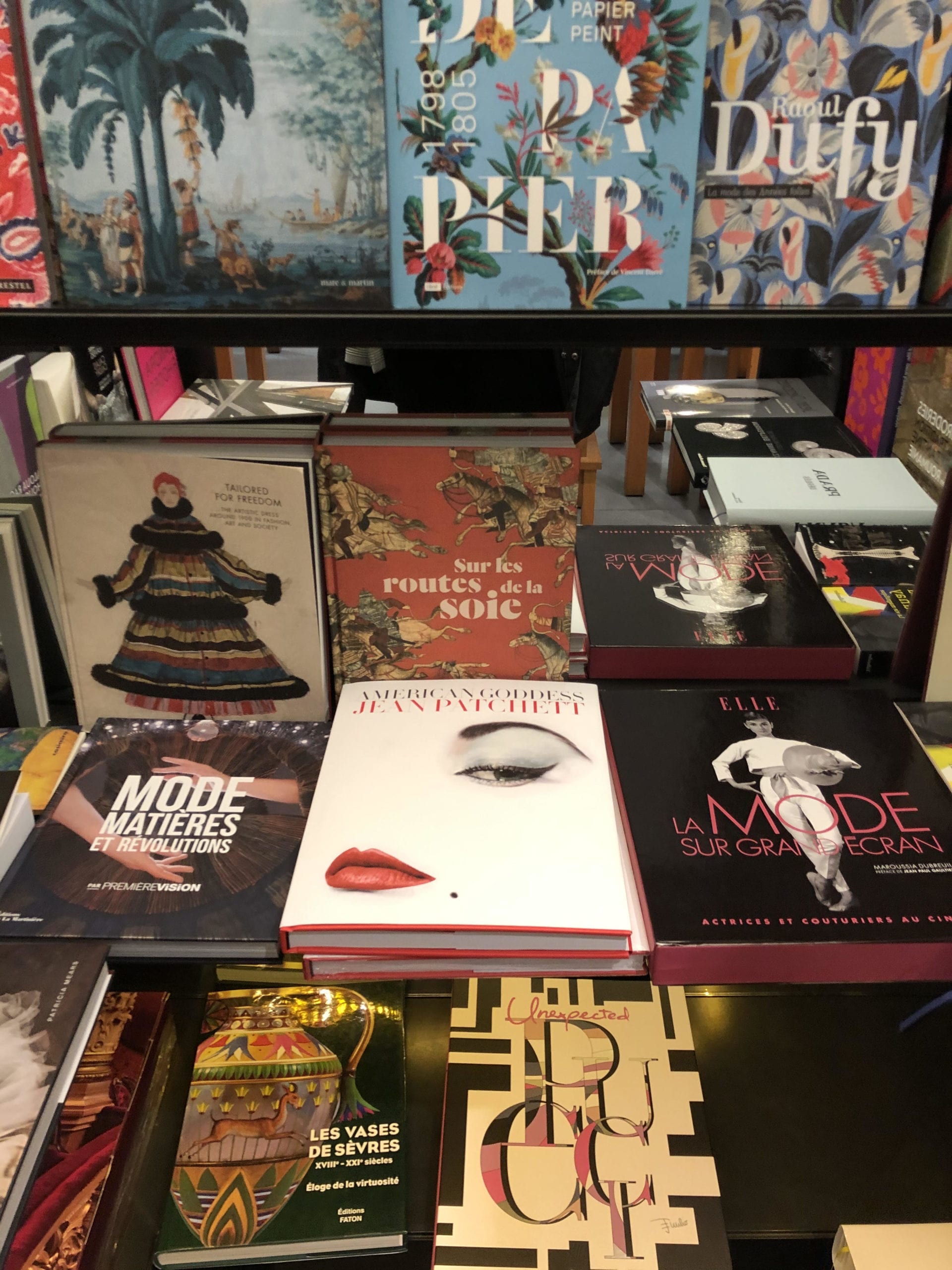
“I have a fatal attraction for books. A disease I don’t want to be cured of…I could not live without them” – Karl Lagerfeld
About 20 years ago, I was at Rizzoli’s bookstore at its old location on 57th Street in NYC. I was standing in the photography section on the skinny 2nd floor mezzanine when I saw a flurry of activity right next to me. There was Karl Lagerfeld taking book after book from the shelves and placing them in an ever-growing pile in the arms of his strong assistant. I was trying to emulate this master at his very own bookstore but had to limit myself to 5 books as there was only enough space in my suitcase.
Karl’s personal book collection numbered well over 300,000 volumes. And the majority of those books were in his private library behind the door in the back of this bookshop. Oh, how I would have loved to have gone through that door to see the double height studio packed floor to ceiling (and 2 floors) with books. He even built bookcases over every door to house more books. This is something I also did in my small Brooklyn apartment. You have to use space where you can find it. Legend has it that he stacked his books horizontally rather than vertically so that he didn’t have to tilt his head sideways to read the titles. He had a sofa that went on for practically the length of the room and an equally long coffee table to match filled with magazines from around the world. Come to think of it, I should have snuck into the library so that I could happily stay there during the quarantine. Don’t they say that “books feed the soul”? I would have been set. Sadly, Karl died a year ago and his estate is still being sorted out. Apparently, he was so keen of living in the moment that he made no plans for the future of his estate. I join the growing chorus of voices asking that this special place be turned into a research library so that this cornucopia of art and design tomes can be enjoyed by all.
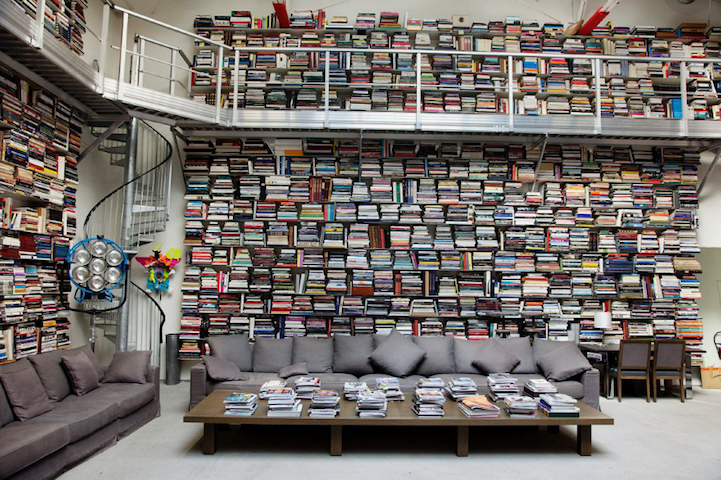
After once again closing down a store (this seems to be a recurring theme for me) I head back to my hotel to read a book before falling asleep and thinking, “When I die, I want to go to Karl Lagerfeld’s library”.
To be continued … à suivre….et à bientôt!
📸 by Jennifer Gyr
Featured image: Antonio Luce

Jennifer Gyr is a Creative Consultant at Par Excellence. After obtaining a degree in Art History and Photography, she was a Helena Rubenstein Intern at MoMA in NYC and she completed the “Works of Art” course at Sotheby’s in London. She then worked for several years at the photography gallery Hamiltons Gallery in London and at Hyperion Press and Keith de Lellis Gallery in NYC. She was a private photography dealer for many years and served as an archivist and curator of a private photography collection in NYC. She also archived the estate of the photographer Horst P. Horst. She has curated several exhibitions and consulted on numerous photo books and exhibitions including with The National Portrait Gallery in London. When not seeking her next travel inspiration she lives in Brooklyn with her Swiss husband.
Share
Paris on my mind by Jennifer Gyr - Day 3
By Jennifer Gyr
I fell in love with Paris when as a teenager I was watching Audrey Hepburn swan through the ville lumière in the movie “Funny Face”. Over the years I have been so lucky to make many trips to this enchanted city with friends and family. My trip in late February was the first time I was in Paris by myself with my limited French vocabulary of “Bonjour”, “Merci” and “Au Revoir” (which even then I would speak in a whisper so that my Southern accent wouldn’t decimate the beauty of the language).
What a magical week it would be. As Audrey said so perfectly, “Paris is always a good idea”!
I am staying on the Left Bank in the 7th arrondissement, one of my most favorite areas of Paris. I picked my hotel, Le Saint, as it is right on the edge of the Carre Rive Gauche which is only a few blocks wide and you can walk everywhere as it is so centrally located. Today I am meeting friends for a gallery tour of the area. I quickly have a coffee downstairs in the breakfast room of the hotel, and I look out the window as Parisians walk by starting their day. It seems like no one is ever late for an appointment here as the pace can be quick but is never hurried. In NYC, we always seem to be running down the sidewalks, always somewhere we need to be in a haste. It is one of those brisk February mornings, and I notice how everyone has their scarves tied in such different and elegant ways. From the young student walking to class to the businessman heading to a meeting, the scarves are wrapped around their necks like sculptures, giving them an effortless chic. Whenever I wear a scarf, it ends up looking like it blew through the wind and landed on me haphazardly.
My hotel is located on Rue du Pre aux Clercs, which translates to “The Meadow of the Clerics”. Apparently in Medieval times, this area was a large meadow and was the site of an old dueling ground. If these grounds could talk… On the way to meet my friends, I stop in a small shop around the corner. What I thought would be a small tabac (the French version of our own corner deli) is instead like going through Alice in Wonderland’s looking glass. One can buy shampoo there, but also wine, cheese, baguettes and the most decadent looking desserts. It gives a whole new meaning to “I am just popping to the corner shop for some milk” (with dessert on the side for good measure).
I then walk one block further and turn the corner onto Rue de Verneuil and see the most glorious shot of color on a dreamy Left Bank street: A “graffitied house” stops me dead in my tracks. As I walk closer to the front door, I see a sign by the bell saying “Gainsbourg”. This was Serge Gainsbourg’s house! The celebrated French singer and icon moved in here in 1969 with his beloved muse Jane Birkin (she would eventually move out later). He lived there until he died in the house in 1991. Its outer wall is an ever-evolving tribute in graffiti and art. His daughter, Charlotte Gainsbourg, has left everything intact inside, just as it was when her father died. Even the butts of his favorite Gitanes cigarettes are still in the ashtray by the piano where he composed many of his famous songs. Serge had all the walls and ceilings of the interior painted black to give him a calming and cocoon like feel. He lived all day with the lights on, so day to night was a blur. Although he was a celebrated musician, he aspired to be a painter. It is fitting that his home’s exterior is a painted homage to him, a living memorial.
I arrive at my friends’ gallery a few minutes late, breathless from my recent discovery. In Paris there is always a magical discovery to be made. My lovely friends Jean-Louis and Aude Herledan own the beautiful 1831 Art Gallery. Aude is a painter and sculptor and I was so pleased to finally see her work in person. After a delicious lunch at a local bistro (with wine of course), we bid adieu to Aude, and Jean-Louis and I set off on an afternoon tour of the neighborhood’s arts and antiques galleries. Jean-Louis is the President of Carre Rive Gauche, an organization representing over 100 arts and antiques galleries located in the heart of the 7th arrondissement. This arts district forms the perfect square as it is bordered by Quai Voltaire, Rue des Saints-Peres, Rue de l’Universite and Rue de Poitiers. It is next door to the Musee d’Orsay and right across the River Seine from The Louvre. As Thomas Jefferson so aptly stated: “A walk about Paris will provide lessons in history, beauty and in the point of life”. I had the perfect tour guide to see about 7,000 years of decorative arts within a few small blocks. I must mention that during the tour I was so caught up in meeting all of the dealers and hearing about their gallery and looking at top pieces that I didn’t take a single photo. I was definitely “living in the moment”. All of the photos here were taken later when the galleries were closed and I took photos of the storefronts.
“A walk about Paris will provide lessons in history, beauty and in the point of life” – Thomas Jefferson
In the course of about 4 hours, we visited around 20 galleries and I could have spent several days more immersing myself in all of them. I saw exceptional antique French clocks from the Louis XIV-Louis XVI periods at La Pendulerie, ceramics from the 17th and 18th centuries at JM Bealu & Fils, paintings by Madeline Grenier at Galerie Antoine Villeneuve, furniture and objets d’art from the 17th-19th centuries at Philippe Vichot, antiques and decorative arts from 1890-1970 at Galerie Lafon-Vosseler and marine and science objects, canes and curiosities at Galerie Delalande. At Gabrielle Laroche they show furniture and sculpture from the Middle Ages, Renaissance and the 17th century. I was so inspired to see up close a French Renaissance cabinet with perspective carving. It brought back my days of being an art history student and learning about perspective in art and to see a fine example from that time period was a revelation. After viewing the museum quality European paintings from the 16th-19th centuries at F. Baulme Fine Arts, Monsieur Baulme brought me downstairs to the basement of his gallery on the Quai Voltaire and showed me a secret door hidden behind a curtain. The door led to a passageway where in the old days one could bring their small boat from the Seine and dock inside the basement area. That was such a wonderful surprise! Next door to the gallery we passed Magasin Sennelier. It is a famous art supply store that opened in this spot in 1887. They sold art supplies to artists such as Cezanne, Degas, Gauguin, Pissarro, Soutine, Modigliani, Kandinsky, Bonnard, Picasso and Karl Lagerfeld among others. The colors they sold were once hand-milled behind the store in a workshop and they even invented several colors including Coral Pink, Cinnabar Green, Helios Red and Chinese Orange. David Hockney used the colors Helios Red and Chinese Orange in his “Grand Canyon” (1998). It is still a much beloved store today. As Jean-Louis and I made our way down the Quai Voltaire at the end of a very inspiring day, we reflected on how wonderful this area of Paris is with its rich artistic heritage. It has long been a haven for all types of artists to live and work such as Juliette Recamier, Charles Baudelaire, Amedeo Modigliani, Alexandre Dumas, Jean Auguste Ingres, Max Ernst, Oscar Wilde and Serge Gainsbourg. They all imbue the spirit of the neighborhood.
“I was so inspired to see up close a French Renaissance cabinet with perspective carving“
With Juliette Recamier in mind, I head off to meet my friend Maik at the nearby restaurant Le Recamier. The restaurant is tucked away on a pedestrian only side street in the heart of St Germain. Only once we settled into our seats and I looked at the menu did I realize why this place is such a beloved Parisian institution. The entire menu was full of souffles! Ok, there might have been a few salads and a meat dish but I quickly realized we could eat an entire souffle meal with both savory and sweet choices. For our main course, we shared a delectable lobster souffle and a mushroom souffle. Sharing is highly recommended as you must taste each flavor. The souffles were like airy clouds and both the lobster and mushroom felt light and creamy. For dessert I couldn’t wait to try the caramel salted butter souffle and then Maik’s choice arrived. A Grand Marnier souffle with an entire bottle of Grand Marnier placed on the table to be able to pour the liqueur over the souffle yourself with no limits (and the bottle was not taken away for some time). Needless to say, we lingered over these treats a long time. It was the perfect way to end this lovely day.
To be continued … à suivre….et à bientôt!
📸 by Jennifer Gyr

Jennifer Gyr is a Creative Consultant at Par Excellence. After obtaining a degree in Art History and Photography, she was a Helena Rubenstein Intern at MoMA in NYC and she completed the graduate “Works of Art” course at Sotheby’s in London. She then worked for several years at the photography gallery Hamiltons Gallery in London and at Hyperion Press and Keith de Lellis Gallery in NYC. She was a private photography dealer for many years and served as an archivist and curator of a private photography collection in NYC. She also archived the estate of the photographer Horst P. Horst. She has curated several exhibitions and consulted on numerous photo books and exhibitions including with The National Portrait Gallery in London. When not seeking her next travel inspiration she lives in Brooklyn with her Swiss husband.
Share
Hervé Obligi, stone sculptor and marquetry artist
Surrounded by amethyst, rock crystal, Tuscan paesine, jade, Armenian obsidian etc. Hervé Obligi exercises a rare profession where the mineral world serves as raw material. Signatures Singulières had the pleasure of meeting this artist of immense talent in his studio in Montreuil.
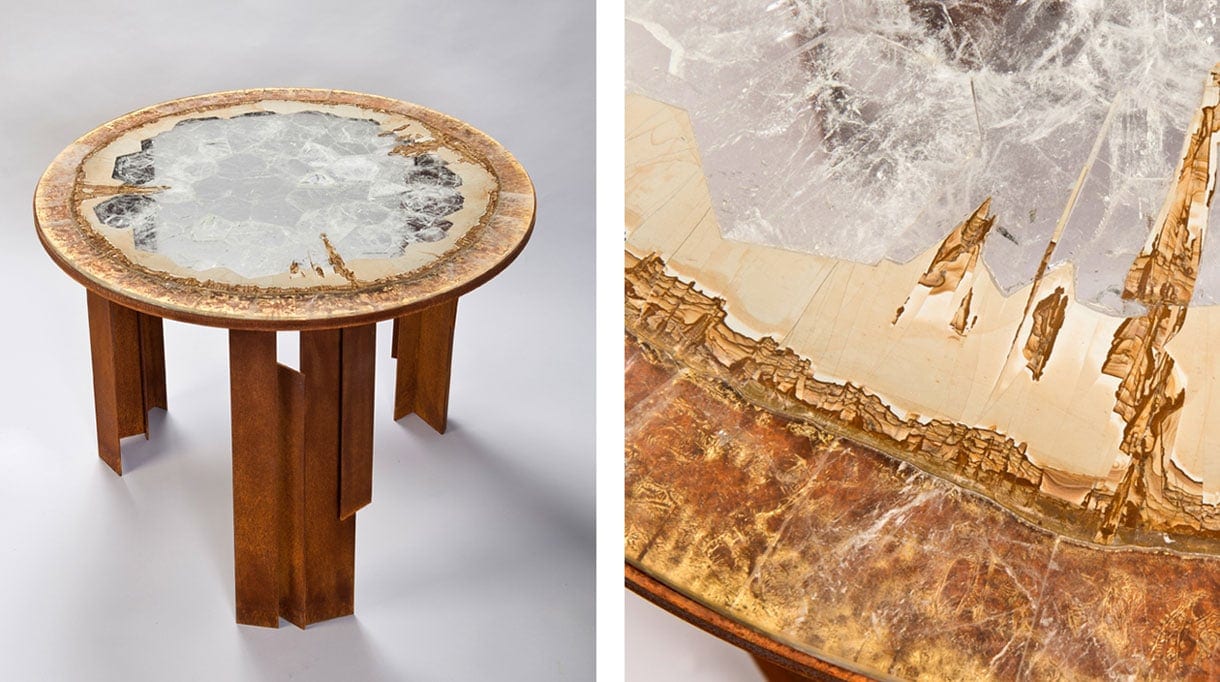
Art and technique
Both craftsman and artist, he works with stone in his workshop in Montreuil. Born in Champagne, this cabinetmaker by training began by working in marquetry and wood carving. But over time, he became a specialist in the cutting of hard stones. In addition, his talents in this area are numerous.
On the one hand, he restores 18th century objects for the Palace of Versailles and the Louvre. On the other, he responds to orders from the Orsay quay and French embassies (New York, Washington, Geneva ONU, London, Moscow, Beirut, etc.).
Most recently, he set about restoring the pavements of the Hotel de la Paiva in Paris. In addition, Hervé Obligi creates unique pieces like these hard stone decorative panels for the French Embassy in Gabon. He also works with big names in jewelry, clocks for Cartier and watches for Piaget.
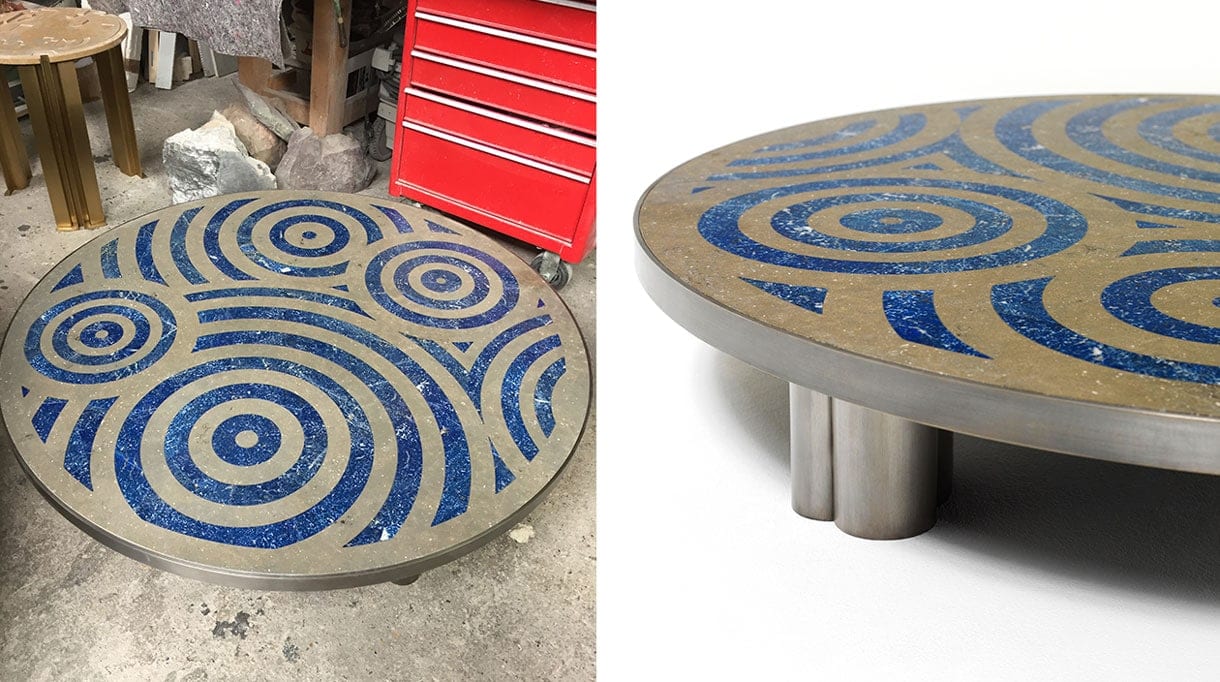
A vast creative universe
Among Hervé Obligi’s creations, there are precious watch faces but also extraordinary fountain pens designed as real sculptures. Or a table made of rock crystal, Tuscan paesine and gold or in Lapis Lazuli and marble stone from Buxy. In addition, many mysterious creations are added to the already long list of his achievements. Without forgetting his participation in a number of works with international decorators and antique dealers! Finally, he exhibits in many countries and since 2016 he has been represented in New York by the Maison Gérard gallery.
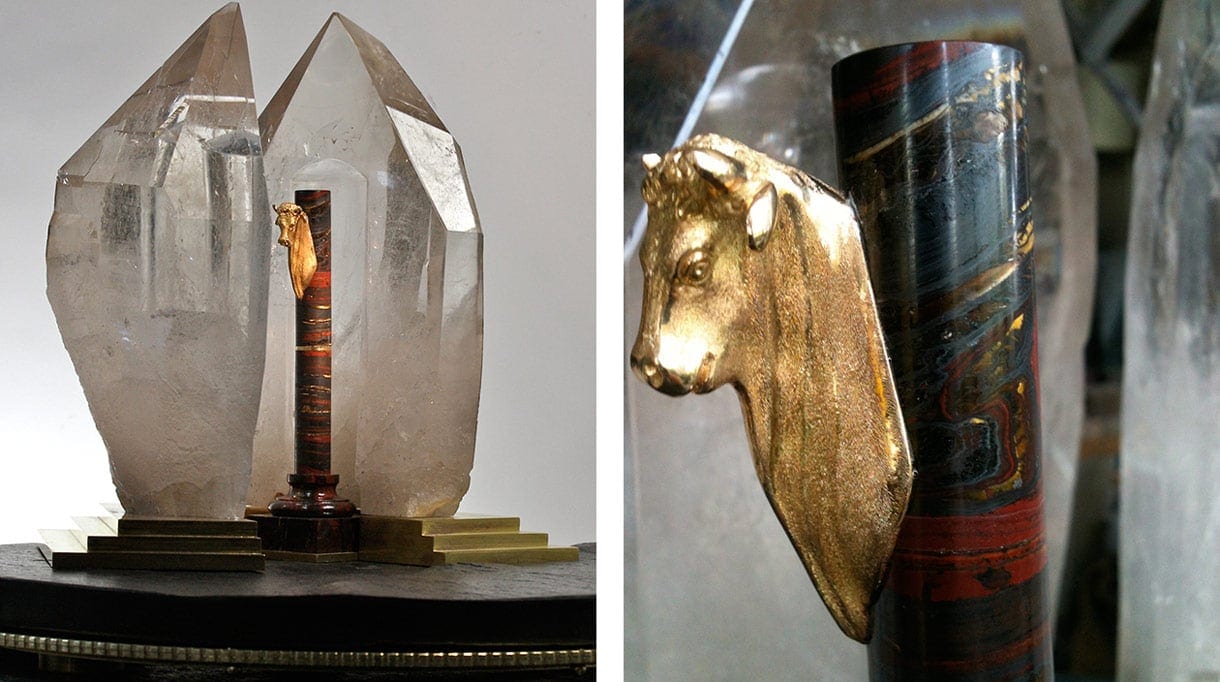
A unique and ancestral know-how
This art of engraving on hard, precious or fine stones with nuances and unique properties, is called glyptics. This includes the size, and the hollow sculpture (intaglio) or relief (cameo). Glyptic know-how is recognized in France by its inclusion in the inventory of intangible cultural heritage. For this reason, appointed Master of Art in 2015, title awarded for life, Hervé Obligi will notably have the mission of transmitting the excellence of his knowledge and skills to a student of his choice.
